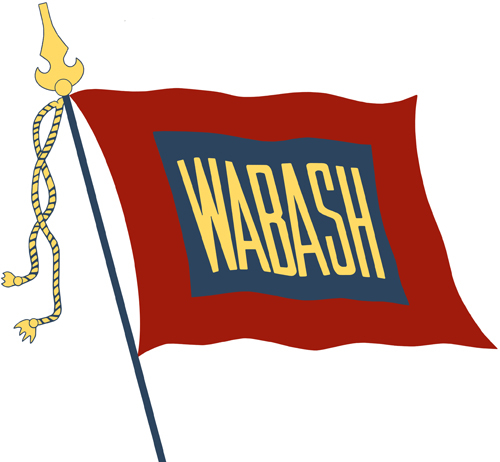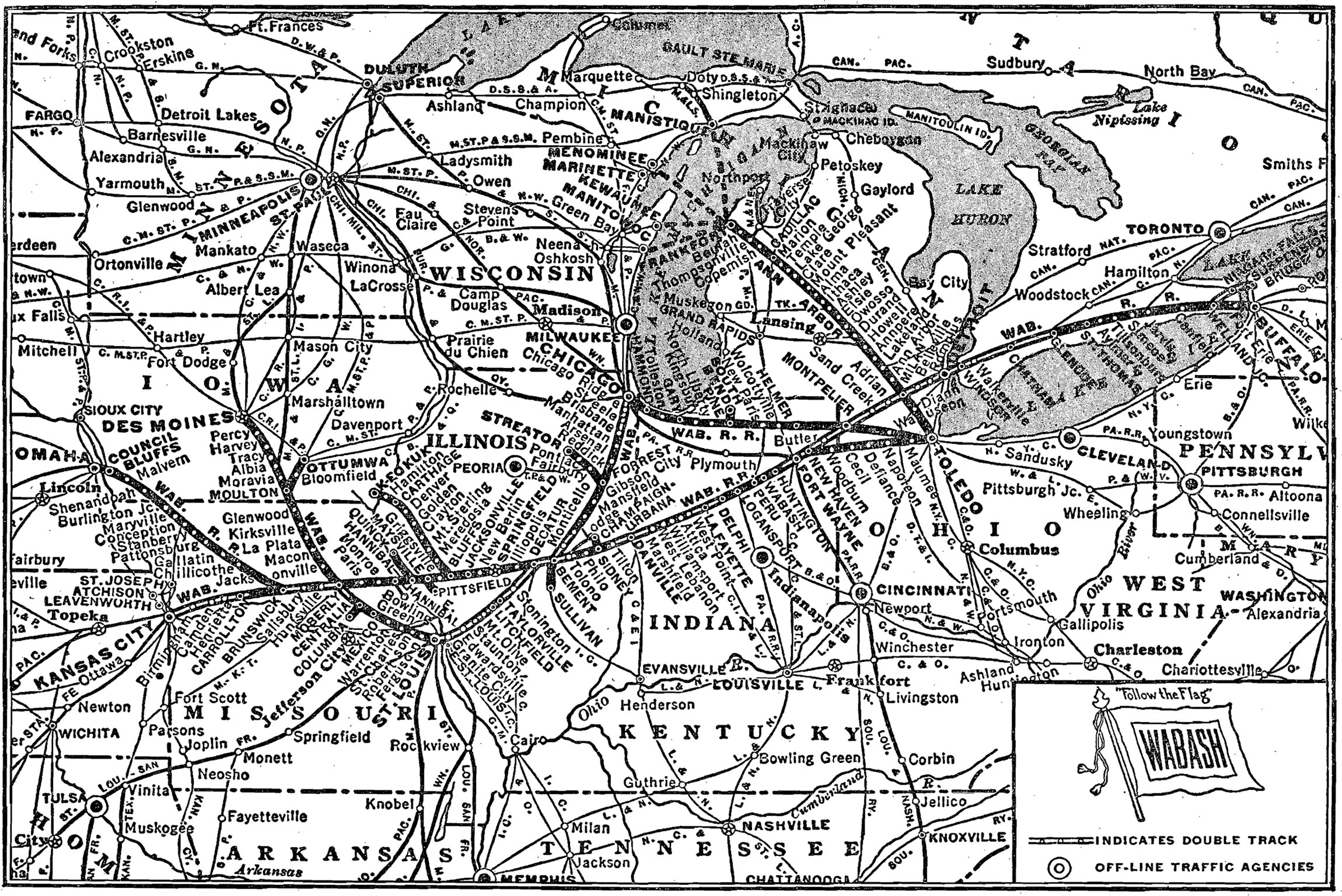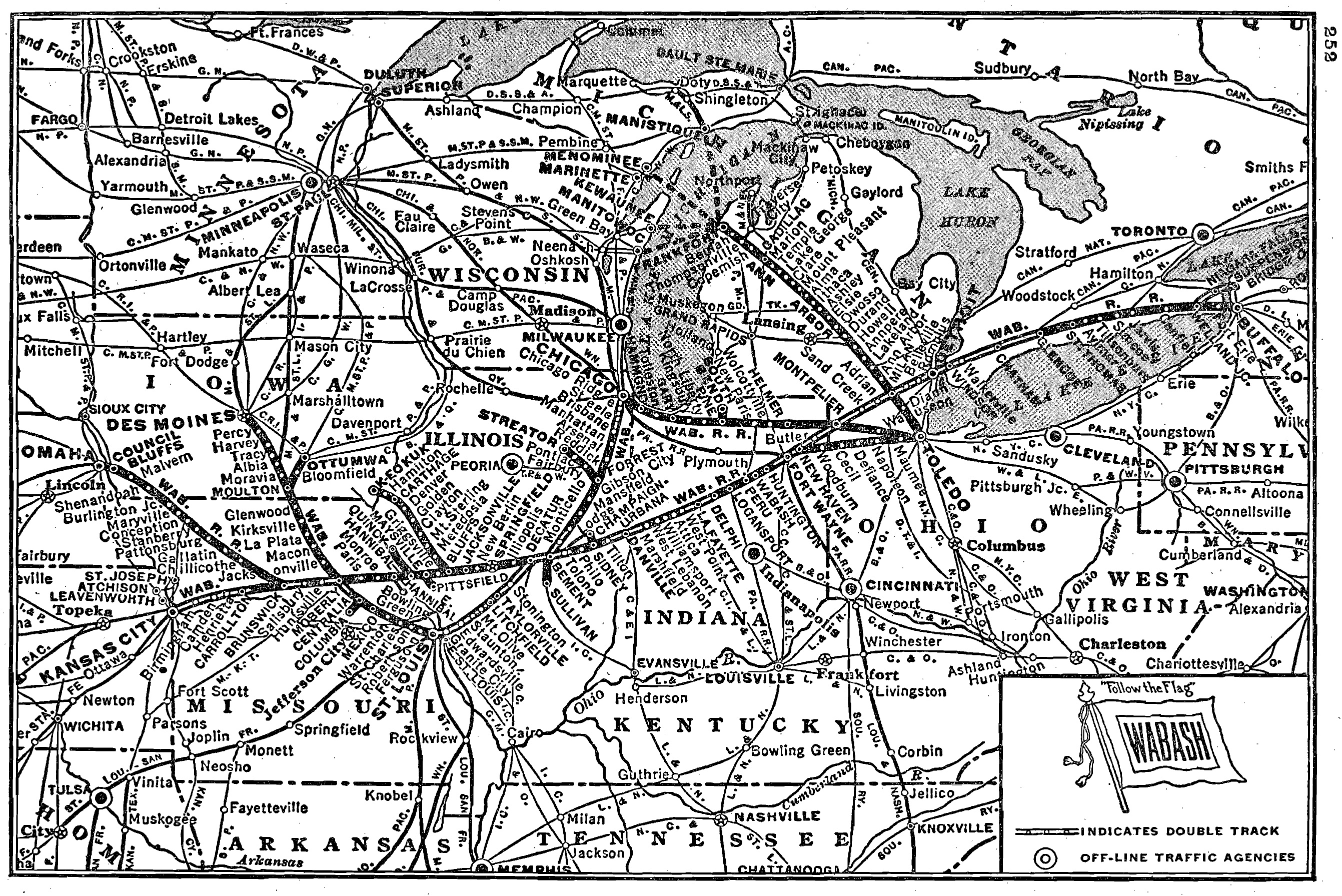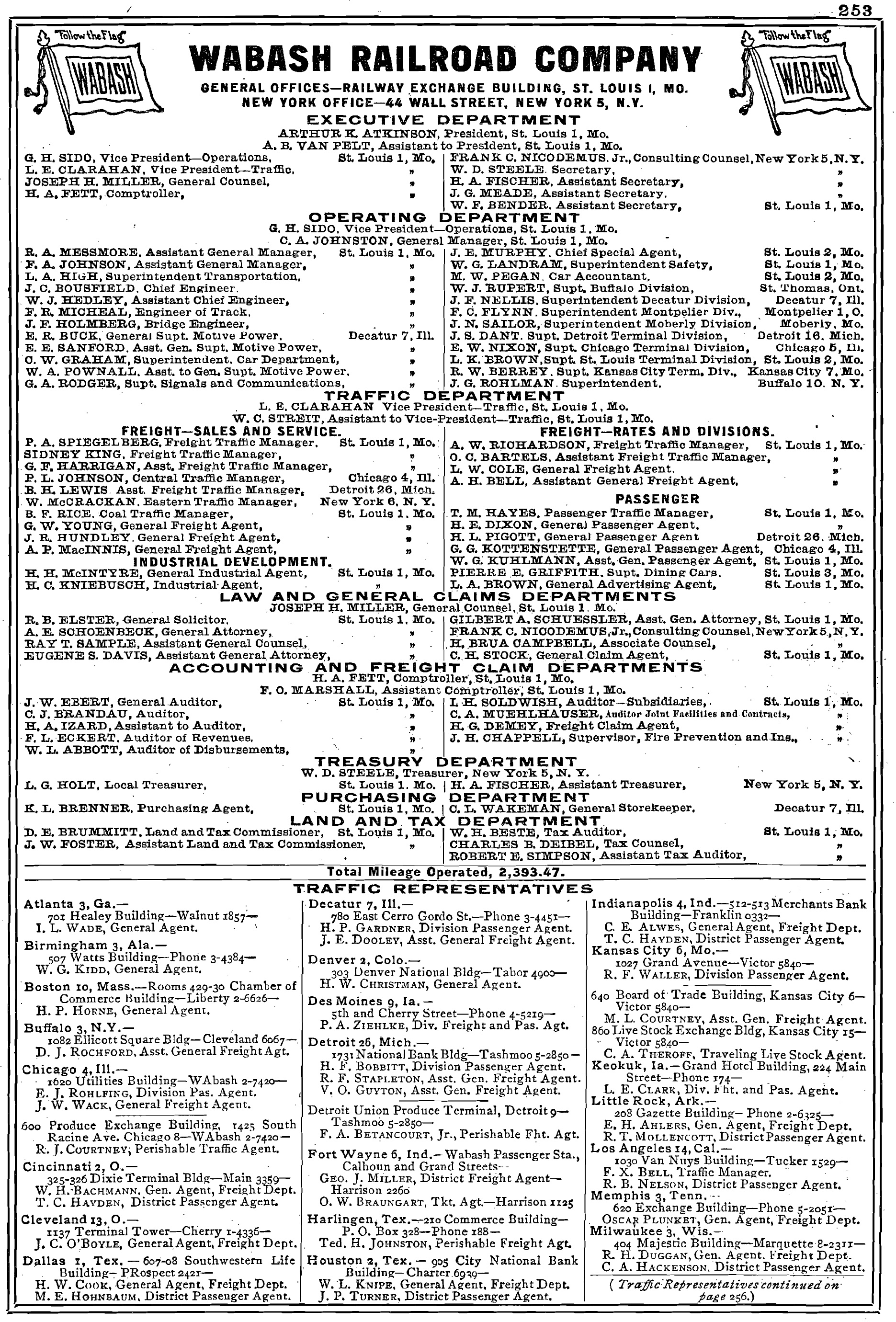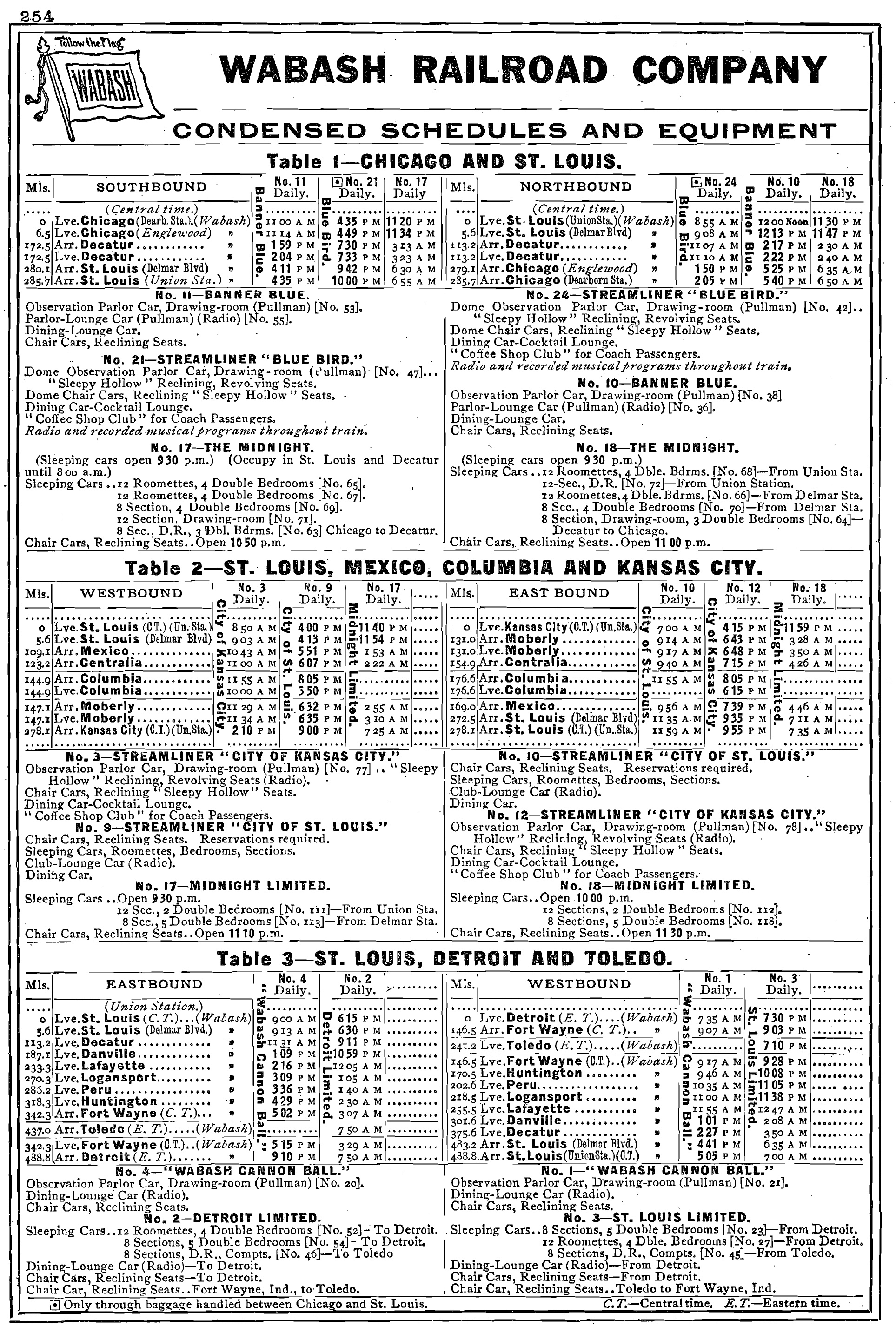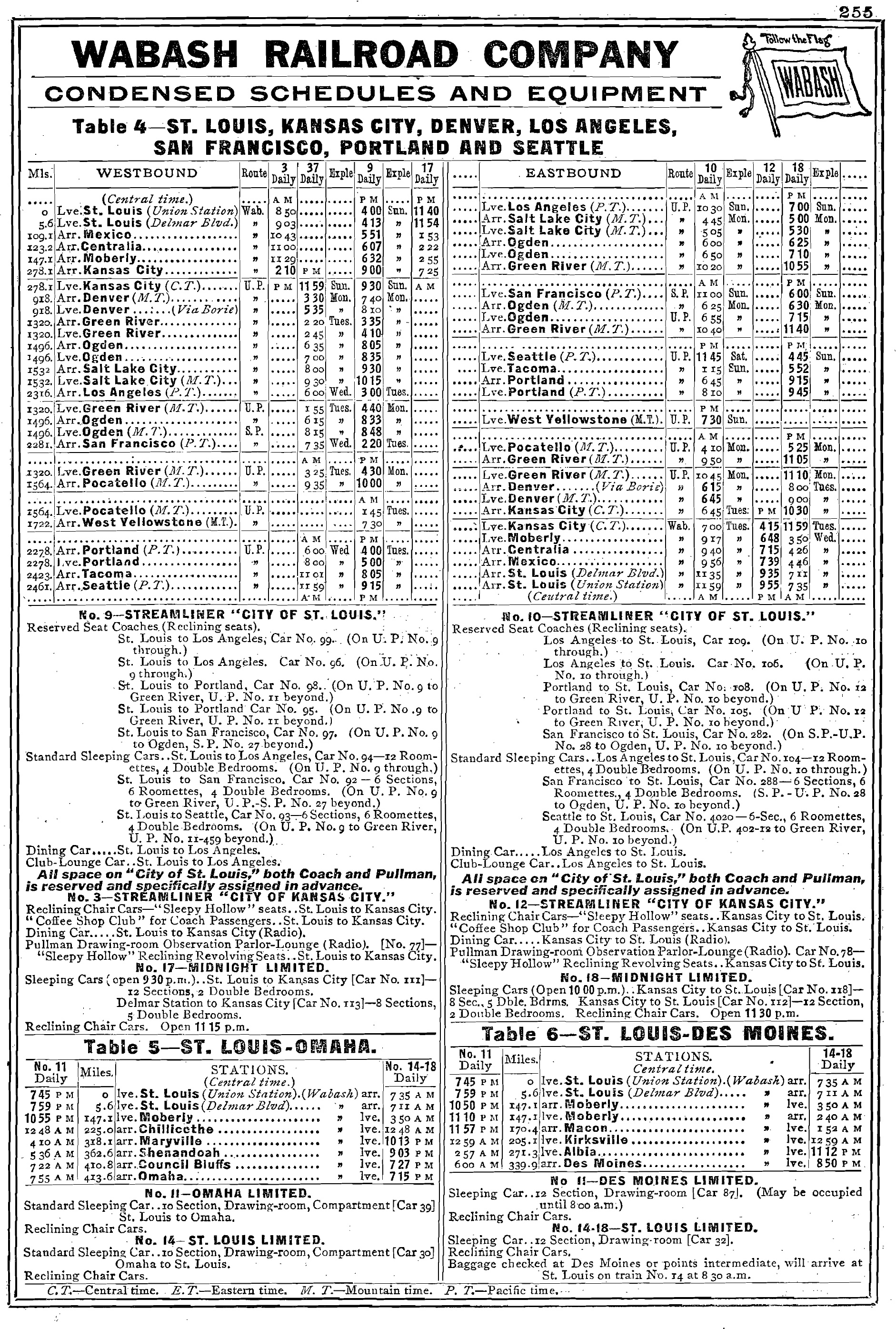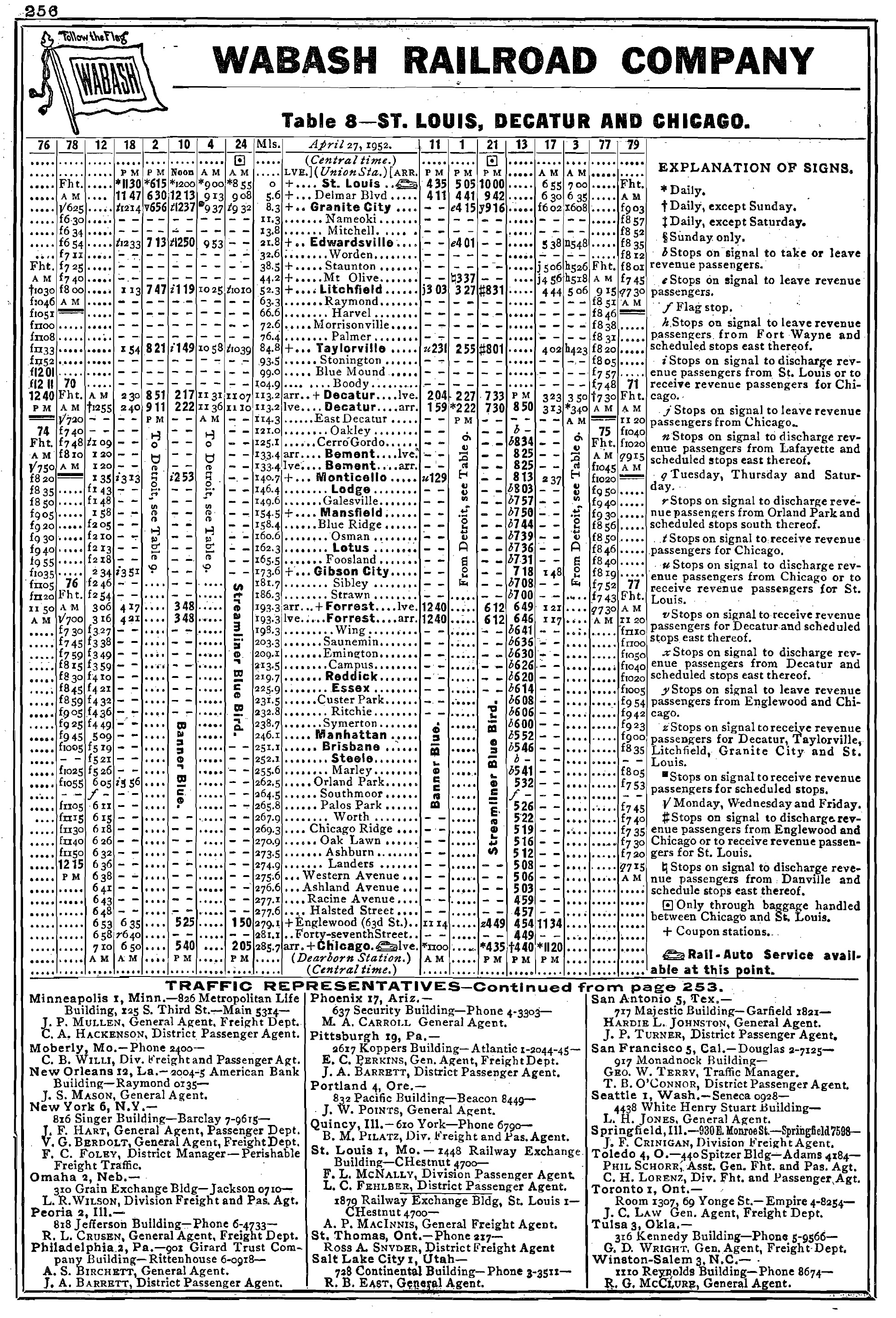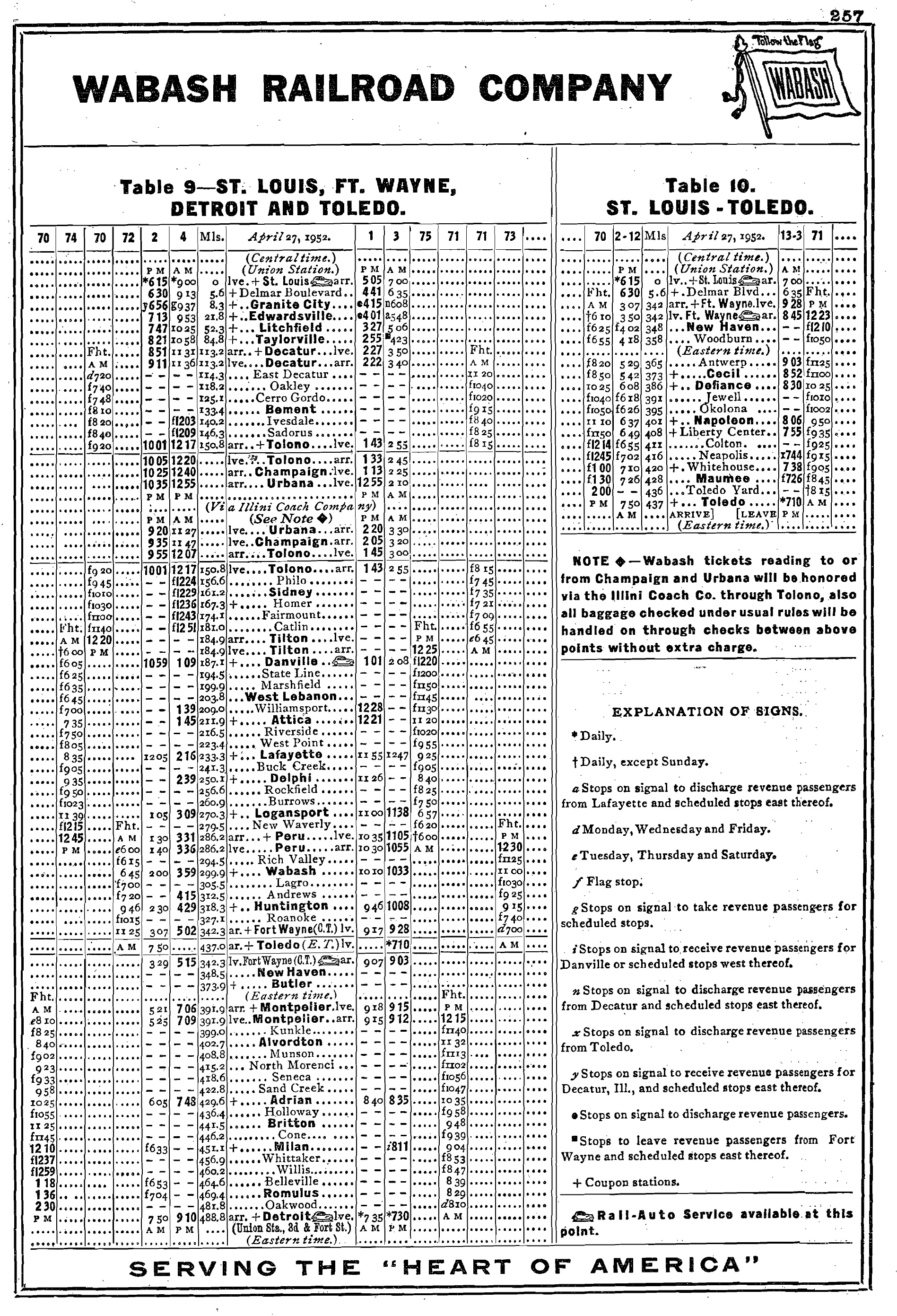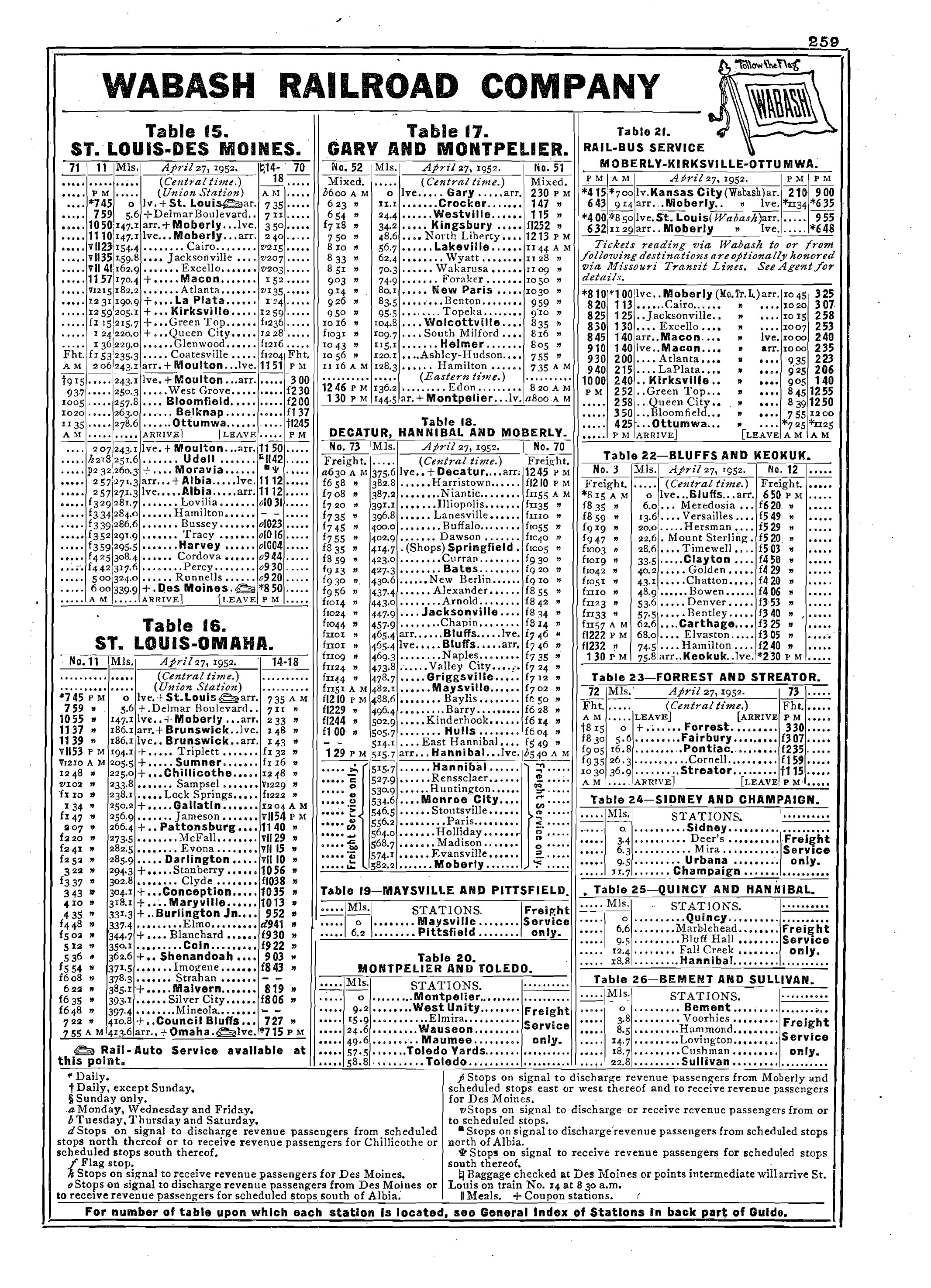- Home ›
- Fallen Flags ›
- Wabash
Wabash Railroad: Map, Rosters, History, Logo
Last revised: October 16, 2024
By: Adam Burns
While it was only a Midwestern bridge line the Wabash Railroad carried a fascinating heritage. It earned pop culture status thanks to the folk song "The Wabash Cannonball" (which eventually led to a train of the same name) and flew a legendary logo with the slogan, "Follow The Flag."
Its corporate history was a roller-coaster affair of prosperity and struggle. During its formative years the company did relatively well until Jay Gould gained control in the late 1870's.
This ruthless speculator tried to incorporate it into his planned transcontinental system but the scheme failed when overextended financing led to bankruptcy.
Gould retained ownership and his son later inherited the empire in 1896. When George also ran into monetary trouble, just over a decade later, the family's involvement forever ended.
The Wabash prospered after this time thanks to its many key corridors which handled a diversified traffic base. Its modern network was slightly over 2,000 route miles reaching Detroit, Chicago, St. Louis, Kansas City, Omaha, and even Buffalo thanks to a trackage rights agreement.
The mighty Pennsylvania Railroad (PRR) acquired stock ownership during the depression era whereupon the Wabash remained a subsidiary until Norfolk & Western's takeover in 1964. Today, many of its principal routes remain in use.
Photos
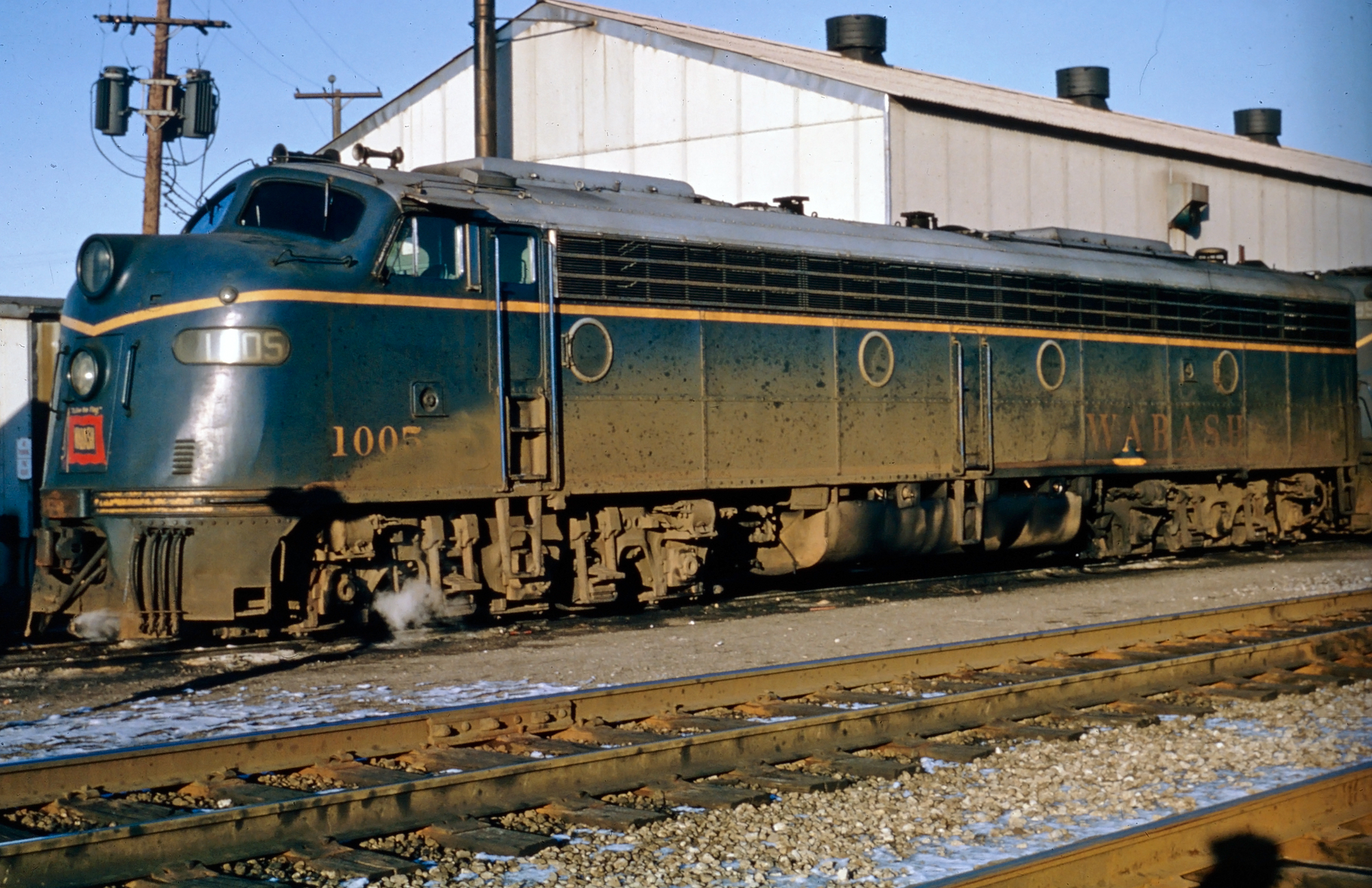 Wabash E8A #1005, in need of a bath, at Melvindale, Michigan on January 3, 1965. Photographer unknown. American-Rails.com collection.
Wabash E8A #1005, in need of a bath, at Melvindale, Michigan on January 3, 1965. Photographer unknown. American-Rails.com collection.History
Their stories may have been very different but the Wabash and New York, Chicago & St. Louis (Nickel Plate Road) were quite similar; they were roughly the same size, served many of the same markets, and prospered during the 20th century.
In addition, both wound up as components of a greatly expanded Norfolk & Western during the mid-1960's. For the Wabash, its path to success was far rockier and uncertain.
Things began amid great fervor when Illinois passed a transportation improvement act during 1837 which sought to interlink the state with 1,342 miles of new railroad at a cost of $10 million.
At A Glance
2,524.20 (1930) 2,393 (1950) | |
Buffalo, New York - Detroit, Michigan - Fort Wayne, Indiana - Decatur, Illinois - Springfield, Missouri - Moberly, Missouri - St. Louis Chicago - Decatur - St. Louis St. Louis - Moberly - Des Moines, Iowa Brunswick, Missouri - Council Bluffs, Iowa/Omaha, Nebraska Toledo, Ohio - Chicago Bluffs, Illinois - Keokuk, Iowa Toledo, Ohio - Frankfort, Michigan Fort Wayne, Indiana - Toledo Frankfort - Manitowoc/Kewaunee/Menominee/Manistique, Wisconsin (car ferry service across Lake Michigan) |
|
Freight Cars: 14,240 Passenger Cars: 126 | |
One part of this endeavor was the Northern Cross Railroad, projected to connect Quincy and the Indiana state line at Danville, via Springfield and Decatur. The entire scheme was a dismal failure although it did manage to complete 56 miles between Meredosia and Springfield by October of 1841 before money ran out.
According to historian Mike Schafer's book, "More Classic American Railroads," a little 4-2-0 named Rogers was the first locomotive to operate in Illinois when it rumbled over the initial 8 miles between Meredosia and Morgan City on November 8, 1838.
As the Northern Cross struggled the state decided to lease the property in hopes of turning around its fortunes. Private interests took over in May of 1842 but, unfortunately, their efforts also proved futile. With the no relief in sight it was sold on April 26, 1847 to Nicholas Ridgely, a successful Springfield speculator.
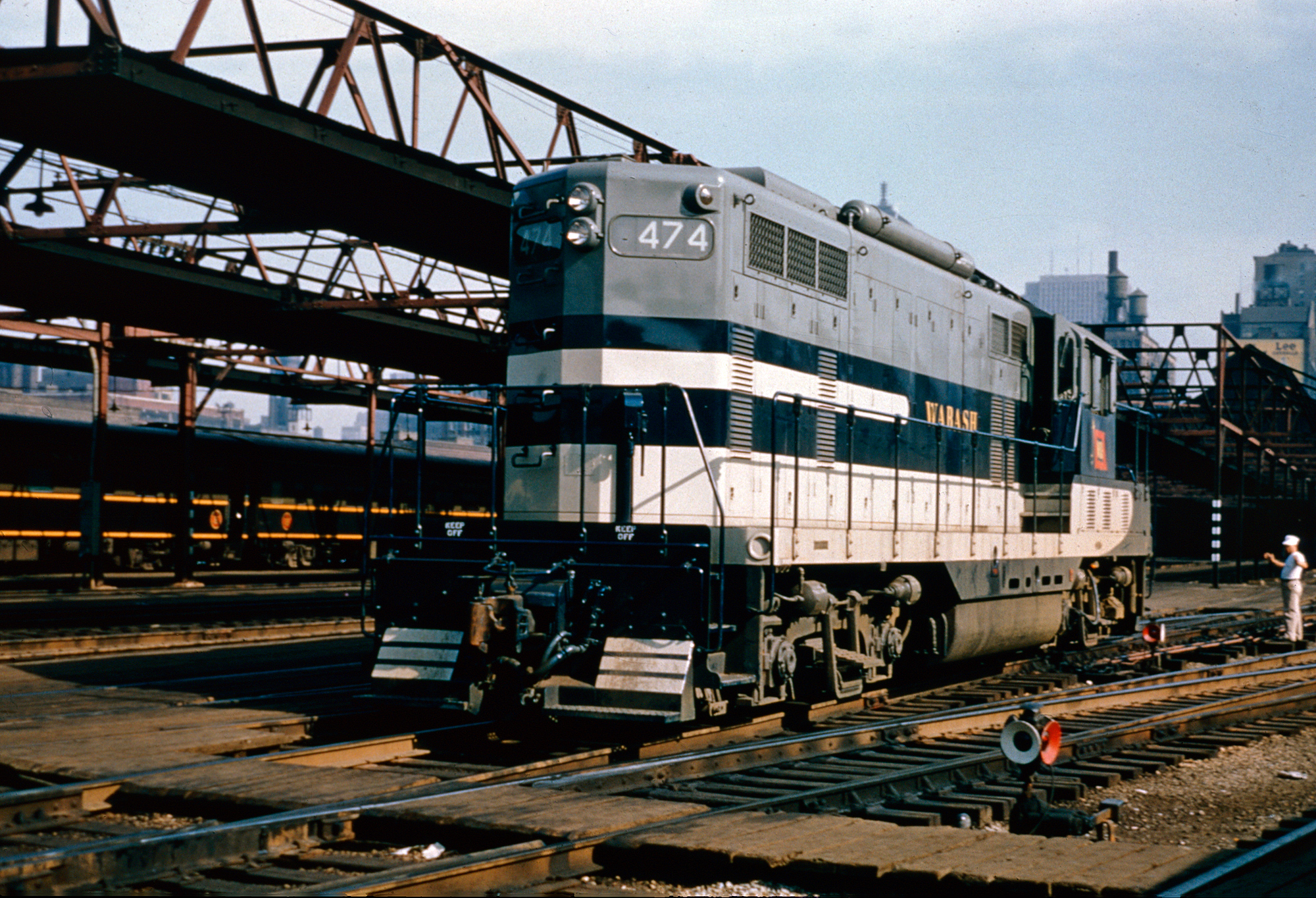 Wabash GP7 #474 navigates the lead tracks at Chicago's Dearborn Station on February 10, 1955. This unit was equipped with a steam generator for passenger service. American-Rails.com collection.
Wabash GP7 #474 navigates the lead tracks at Chicago's Dearborn Station on February 10, 1955. This unit was equipped with a steam generator for passenger service. American-Rails.com collection.Although he played a rather inconsequential role in the company's history, he is credited with providing it a solid financial footing. He subsequently sold part of his interest to businessmen Thomas Mather of Springfield and James Dunlap of Jacksonville who reorganized it as the Sangamon & Morgan Railroad.
They spent considerable money to restore rail service and then sold their stake to New York City investors for $100,000.
On July 22, 1849 trains began running once more while the western rail-head was extended from Meredosia to nearby Naples. On February 13, 1853 another reorganization took place, this time as the Great Western Railroad.
It was under this title that considerable expansion occurred; by November of 1856 rails had reached Danville, as well as connections with the Illinois Central, (then the country's largest railroad) which opened new traffic opportunities.
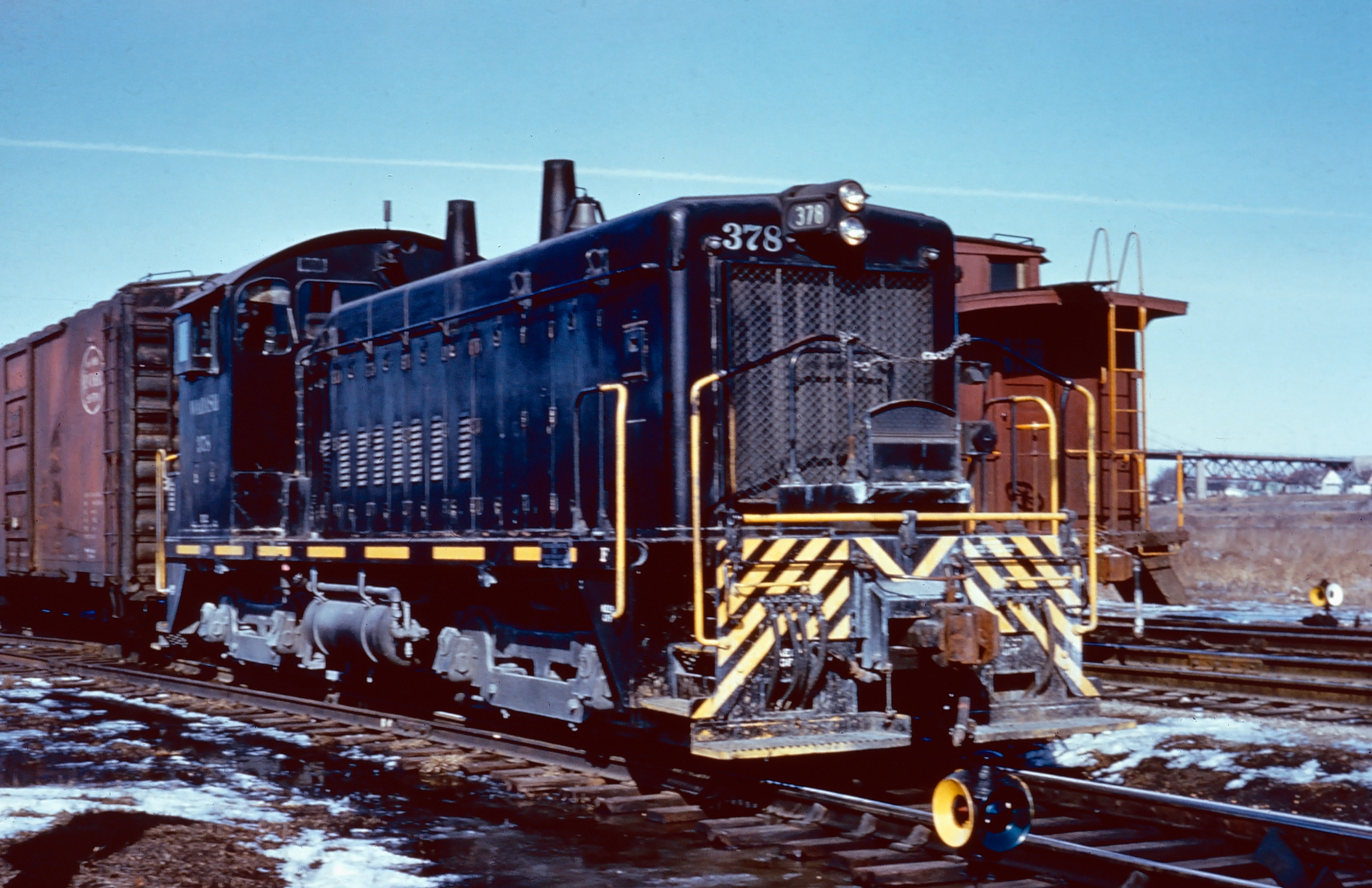 Wabash SW1200 #378 was photographed here in Toledo, Ohio on February 12, 1962. Photographer unknown. American-Rails.com collection.
Wabash SW1200 #378 was photographed here in Toledo, Ohio on February 12, 1962. Photographer unknown. American-Rails.com collection.Just as things were looking up the financial Panic of 1857 led to another reorganization as the Great Western Rail Road (GWRR).
This latest entity had only been in operation for a few years when it merged with the Toledo & Western Rail Road (T&W) in June of 1865 to create the Toledo, Wabash & Western Railway (TW&W).
The T&W was a consolidation itself that had been formed on October 8, 1858; by connecting with the Great Western at the Illinois/Indiana state line the TW&W boasted a 522-mile network stretching from Quincy and Keokuk, Iowa (reached through GWRR's lease of the Illinois & Southern Iowa Rail Road) to Toledo, Ohio.
Notable intermediate towns included Lafayette, Peru and Fort Wayne, Indiana. As author H. Roger Grant points out in his authoritative title, "'Follow The Flag,' A History Of The Wabash Railroad Company," the TW&W was an immediate success thanks to the region's rich agriculture opportunities and rapidly expanding population.
It carried no outstanding debt and grossed more than $4 million by 1868. With so much cash available it's not surprising that further growth was soon in order.
In 1869 it began laying sections of steel rail, in place of iron, and then acquired the Decatur & East St. Louis Rail Road during August of 1870. This 109-mile carrier connected its namesake cities and provided access into the important gateway city of St. Louis.
Logo
Origins of the Wabash logo date back to 1886 when the railroad began featuring a flag and banner in red with the words "The Wabash Line" displayed in gold, encompassed within a smaller blue rectangle.
It proclaimed itself "the Banner Line of the Central States" which was later shortened to "the Banner Route" during the 1890's.
In 1912 the company adopted the now widely-recognized slogan "Follow The Flag." While the phrase is most commonly thought to straightforwardly mean use the railroad for all one's shipping and travel needs, Mr. Grant points out it may actually have origins dating back to a 19th century predecessor, the North Missouri Railroad.
According to the Wabash, "An engine carrying what was known as a pay flag went over the road just the day ahead of the pay car...[for] the purpose of letting all employees know the pay car would come the next day. From the fact that the pay followed the flag, came the coining of the remark, 'follow the flag.'"
Whatever may have been the case it was a simple but brilliant marketing tactic which certainly earned the Wabash arguably the most innovative logo and slogan of all time.
Another important lease was the Hannibal & Naples Railroad which reached Hannibal, Missouri along the west bank of the Mississippi River.
From here, points further west could be accessed. Once more, just as the railroad seemed poised for greatness, bankruptcy occurred during February of 1875 as a result of 1873's financial panic.
Expansion
Because it was so well positioned and still garnering respectable business the reorganization was brief. It emerged on January 10, 1877 as the Wabash Railway, the first of many similar names it would carry during next half-century. What followed was a whirlwind of activity that saw Jay Gould gain control.
It all began when Cornelius "Commodore" Kingsland Garrison acquired the St. Louis, Kansas City & Northern (StLKC&N) in early 1877. This 582-mile property connected St. Louis with Kansas City while a northern branch from Moberly reached Ottumwa, Iowa.
Just a year later, in November of 1878, he added the Wabash. During his brief stint, Garrison did much for both railroads. By 1879 Gould had acquired a rather substantial block of Wabash stock and then convinced Garrison to sell him the rest while picking up the StLKC&N in the process.
For the man's many shortcomings Gould's efforts created much of the modern Wabash system. After establishing control of both properties he merged them into the new, 1,400-mile Wabash, St. Louis & Pacific (WStL&P) during November of 1879.
A year later the Wabash got into Chicago when it opened a 90-mile extension north of Strawn, built as the Chicago & Strawn Railway.
Below this point the previous Wabash Railway had picked up the small Chicago & Paducah Railroad in 1877 that was working on a route from Streator to Effingham (via Strawn), crossing its main line at Bement.
System Map (1950s)
To reach Chicago's downtown the Chicago & Western Indiana was utilized, which provided access into Dearborn Station (a facility shared with the Santa Fe, Chesapeake & Ohio, Chicago & Eastern Illinois, Erie Railroad, Grand Trunk Western, and Chicago, Indianapolis & Louisville Railway [Monon]). The first passenger train from Chicago to St. Louis was inaugurated on August 9, 1880.
As the WStL&P built eastward it also looked to the west and the Council Bluffs/Omaha gateway. An interchange with the transcontinental Union Pacific was a goal for many Midwestern lines and the WStL&P was no different. It opened just such a connection in October of 1879 through a combination of lease and new construction.
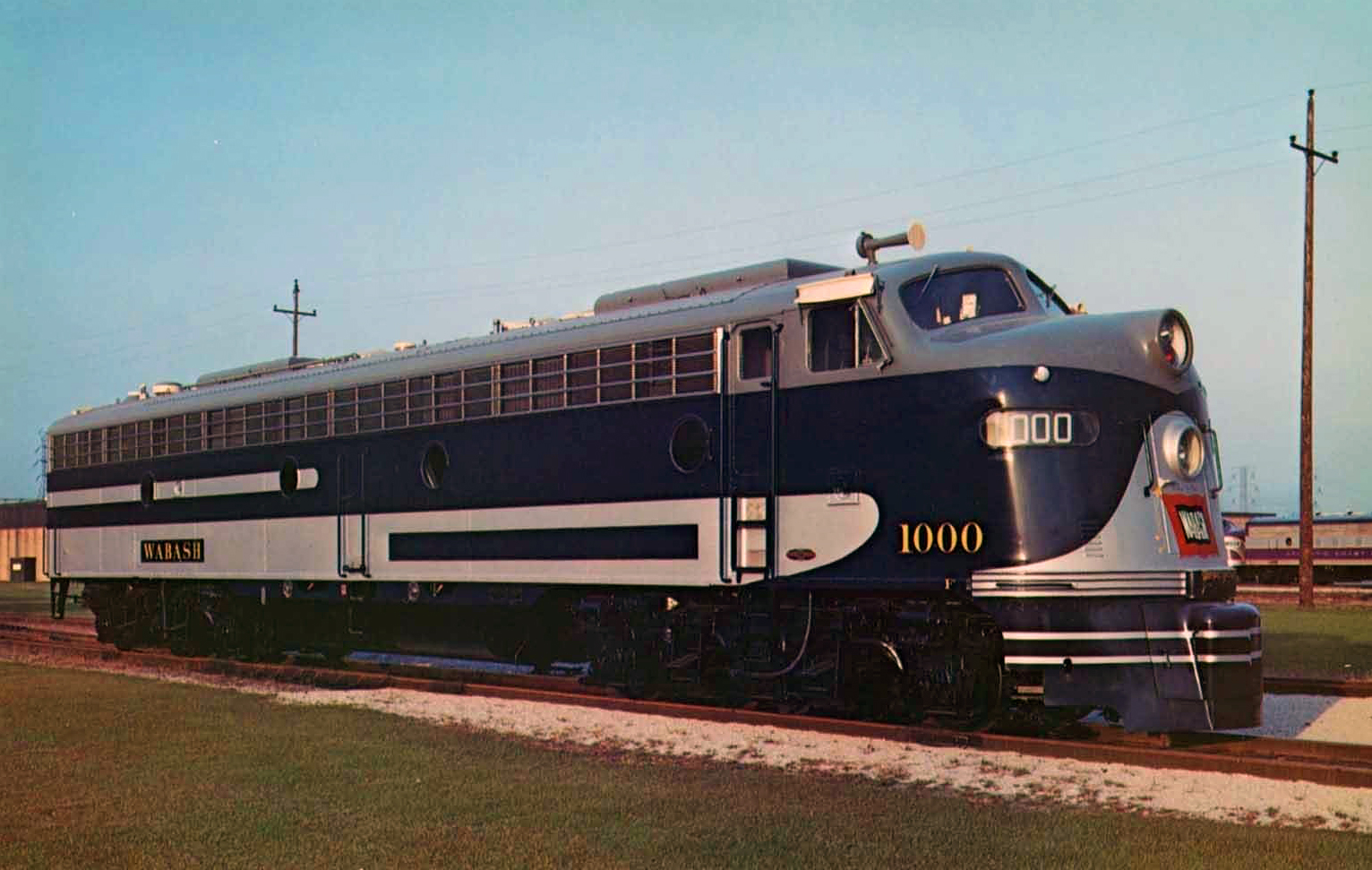 An Electro-Motive company photo of Wabash E8A #1000 during October of 1951; the unit was originally an E7A outshopped in 1946 but returned to EMD and rebuilt to E8 specifications. Note the new Atlantic Coast Line covered wagons in the background. Author's collection.
An Electro-Motive company photo of Wabash E8A #1000 during October of 1951; the unit was originally an E7A outshopped in 1946 but returned to EMD and rebuilt to E8 specifications. Note the new Atlantic Coast Line covered wagons in the background. Author's collection.While all of this was ongoing an extension to Detroit was also underway. First, the 93-mile Eel River Railroad, connecting Logansport with Butler, Indiana, was leased in 1879. Then, the Detroit, Butler & St. Louis was incorporated to finish the remaining 114 miles into Detroit.
The work was finished in short order and the new corridor formally opened on August 14, 1881. As Gould rapidly expanded the Wabash, mostly by leasing smaller carriers (one particularly notable addition was the Des Moines & St. Louis Railroad, which provided access to Iowa's capital of Des Moines), it ballooned into a major 3,549-mile operation by 1884.
Unfortunately, in his quest to establish a true coast-to-coast system, he overextended his finances. One-by-one they fell into bankruptcy, including the WStL&P on May 28, 1884.
In the aftermath, nearly all of his leased holdings reverted back to their original owners while the core network serving Kansas City, Omaha, St. Louis, Chicago, Toledo, and Detroit was retained.
The company emerged from receivership on May 15, 1889 as the Wabash Railroad and in typical Gould fashion, the shrewd railroader managed to retain control.
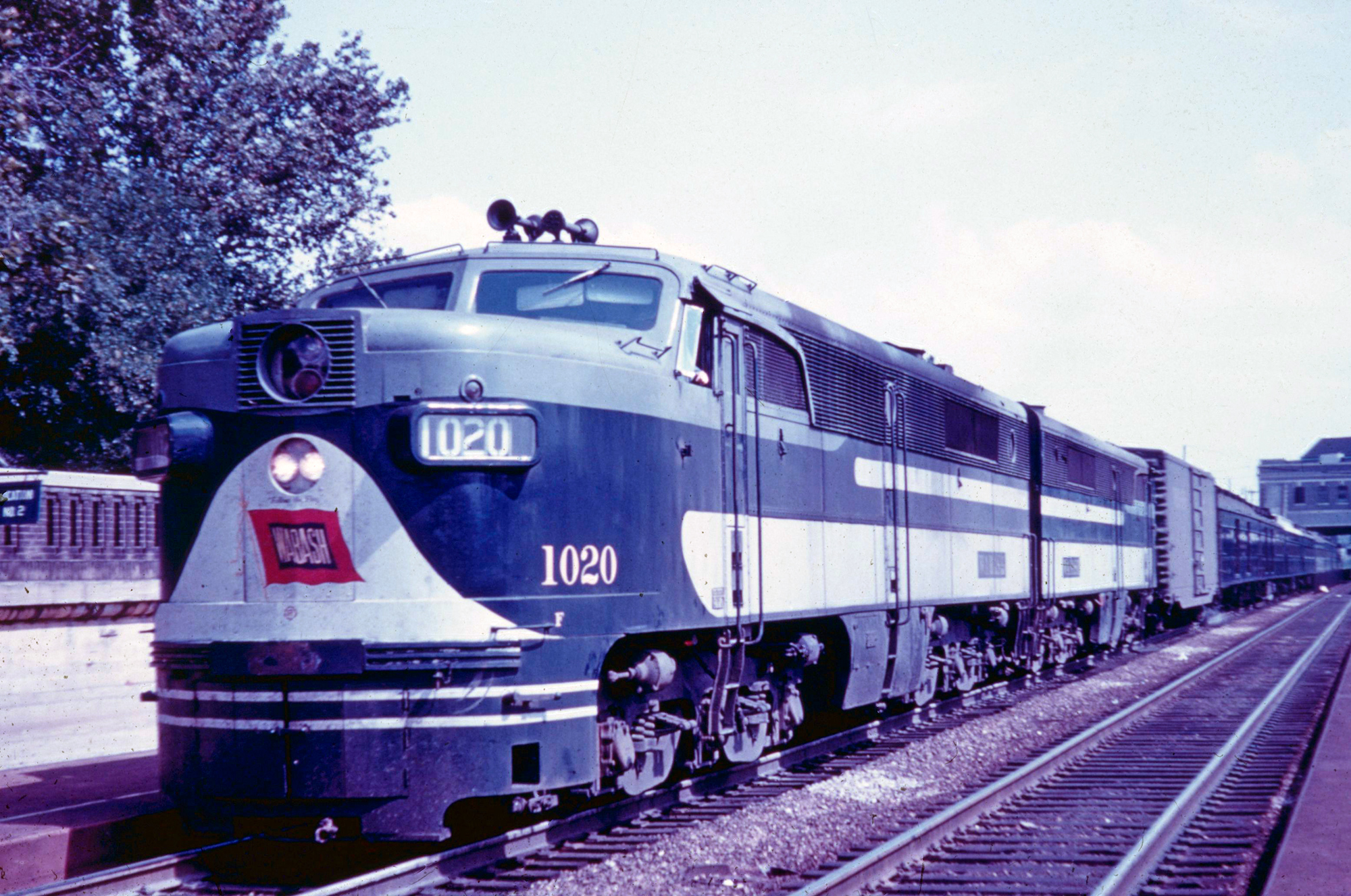 A pair of handsome Wabash PA-1's are stopped at Delmar Station in University City, Missouri (St. Louis) with a northbound/westbound passenger train, circa 1960. American-Rails.com collection.
A pair of handsome Wabash PA-1's are stopped at Delmar Station in University City, Missouri (St. Louis) with a northbound/westbound passenger train, circa 1960. American-Rails.com collection.In 1896, Gould's empire was handed over to his son, George, who continued his father's transcontinental ambitions. By the early 20th century the younger tycoon had, once again, nearly accomplished the feat through control of the Missouri Pacific, Western Pacific, Denver & Rio Grande Western, Western Maryland, and Wheeling & Lake Erie along with the Wabash.
After finishing the W&LE as far as Wheeling, West Virginia, and then extending it eastward into Pittsburgh as the Wabash-Pittsburgh Terminal Railway (completed in 1904), all that remained was a 50-mile segment from Pittsburgh to Connellsville (later built by the Pittsburgh & West Virginia).
In an ironic twist of fate, the younger Gould also overstretched his available capital and his empire collapsed (the Wabash entered receivership once more on December 26, 1911).
George's time at the helm did produce two noteworthy legacies, an improved Chicago corridor and access into Buffalo.
The former was launched in 1891 as the Montpelier & Chicago Rail Road to build a direct route between Detroit/Toledo and Chicago.
This 150-mile connector split from the Detroit main line at Montpelier, Indiana and officially opened on April 21, 1893. In the process, long-time trackage rights over the Erie's Chicago & Atlantic were eliminated.
Reaching Buffalo involved almost no new construction as an agreement was worked out with the Grand Trunk Railway of Canada on January 24, 1898 to lease 230 miles of its system through southern Ontario. Over time, this trackage became a vital component of the Wabash network.
Modern Network
With George's financial ruin, Gould involvement ended for good. The railroad was subsequently sold at foreclosure and reorganized as the Wabash Railway on October 22, 1915. It contained 2,033 route miles, 321 miles of secondary mileage, and 476 miles of trackage rights.
Once free from the Goulds' influence the Wabash reached new heights. It achieved operating revenues of more than $40 million just prior to World War I, thanks, in part, to Detroit's expanding automotive industry. Some of this newfound income was used to bolster infrastructure and purchase new locomotives.
Then, the United States Railroad Administration took over the national industry, made effective at noon on December 28, 1917.
The directive was ordered by President Woodrow Wilson in response to fears of national gridlock. Unfortunately, the government did no better at maintaining fluid operations than the private sector; during this time equipment was rundown and infrastructure inadequately maintained to meet the crushing demand.
The Wabash survived this ordeal better than most and was returned to private ownership on February 28, 1920 following passage of the Transportation Act. That decade was generally good (net operating income reached $12.2 million by 1925) and witnessed a series of interesting events unfold.
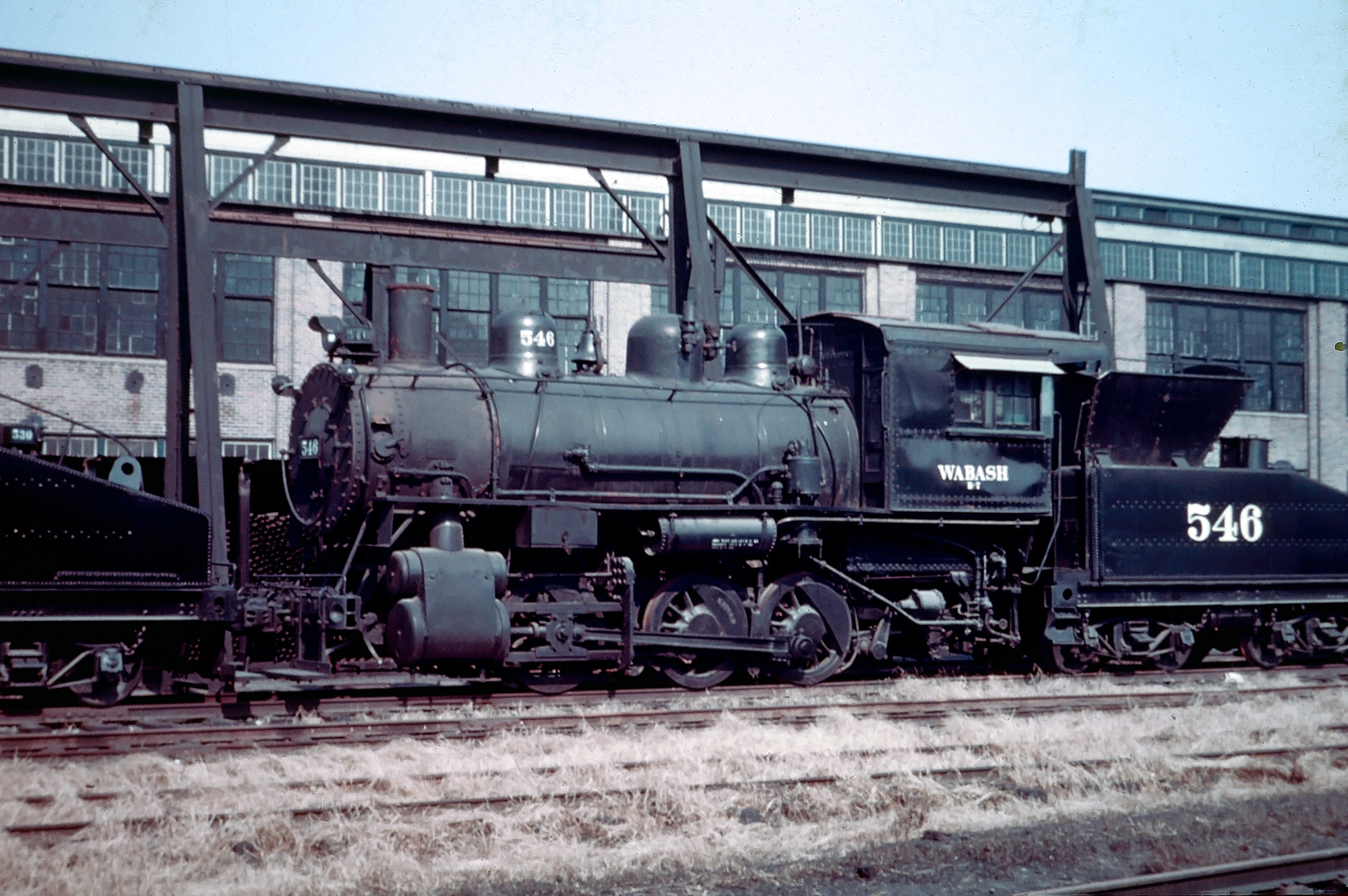 Wabash 0-6-0 #546 (Class B-7), one of the road's many switchers of this wheel arrangement, awaits its fate at the shops in Decatur, Illinois in late 1952. The locomotive, built by Baldwin in October, 1907 (serial 31865) was scrapped in April, 1953. Fred Byerly photo. American-Rails.com collection.
Wabash 0-6-0 #546 (Class B-7), one of the road's many switchers of this wheel arrangement, awaits its fate at the shops in Decatur, Illinois in late 1952. The locomotive, built by Baldwin in October, 1907 (serial 31865) was scrapped in April, 1953. Fred Byerly photo. American-Rails.com collection.First, it acquired stock control of the 292-mile Ann Arbor Railroad in 1925, which maintained a linear route between Detroit and the Lake Michigan car-ferry terminal of Frankfort, Michigan (by 1930 it owned more than 99% of Ann Arbor's stock).
This was all part of a larger effort by board chairman William Williams and Delaware & Hudson president Leonor Loree to create the so-called "Fifth System," a giant Midwestern carrier to rival trunk lines Baltimore & Ohio, Pennsylvania, and New York.
This wasn't a new concept and actually fell in line with the Interstate Commerce Commission's plan then to merge all eastern systems (outside of New England) into a handful of large mega-railroads. The group which actually came closest to achieving this was the Van Sweringen brothers.
Using the New York, Chicago & St. Louis (Nickel Plate Road) as the nucleus their effort involved forming a 9,200-mile railroad, the so-called "Greater Nickel Plate System."
As for Loree and Williams, their plan included the Wabash, D&H, Ann Arbor, Lehigh Valley, Pittsburgh & West Virginia, Western Maryland, and Buffao, Rochester & Pittsburgh to create a 7,000+ mile network. Unfortunately, the Fifth System fell through when the ICC refused D&H control of the BR&P.
In addition, the PRR, which had once oddly endorsed the plan, suddenly turned against it and over time acquired stock control of the Wabash (as well as the LV).
This takeover led to a bitter court battle, which saw the PRR victorious when a deadlocked Supreme Court on March 19, 1934 stayed an earlier Third Circuit Court of Appeals decision that Penny's takeover would not lessen competition.
In the end, the PRR largely stayed out of Wabash affairs enabling its prominent rise into an important and profitable Midwestern bridge line.
It suffered one last financial setback, however, when the Great Depression plunged it back into bankruptcy on December 1, 1931. In 1928 the company enjoyed a net income of more than $11.9 million.
Alas, this melted to a staggering net lose of $7.05 million by the end of 1931. While reorganization would require more than a decade the railroad slowly rebounded as the economy recovered; from an operating income that stood at a low of $31.691 million in 1931 the Wabash showed a strengthening bottom line over the next few years.
It reached $46.133 million in 1937, dipped to just over $40 million a year later, and then boasted a net income of $1.067 million during the first quarter of 1942. With a bright outlook, it was officially reorganized as the Wabash Railroad Company on January 1, 1942.
The World War II years witnessed bountiful business, peaking in 1943 when it enjoyed a net income of $8.758 million. These strong numbers continued in the postwar years as this figure had jumped to $10.997 million by 1948.
The Wabash used its healthy earnings to further infrastructure improvements and sought retirement of the steam locomotive, a process completed on July 28, 1955.
A few years earlier it had also taken part in another industrial transformation, the streamliner, by introducing the City of Kansas City on November 24, 1947.
It was a daytime train between Kansas City and St. Louis featuring new lightweight equipment from American Car & Foundry that included a standard baggage, baggage-mail, diner, coffee-shop coach, two standard coaches, and an observation parlor car all powered by Electro-Motive's new E7 diesels.
Passenger Trains
Banner Blue: (Chicago - St. Louis)
Blue Bird: (Chicago - St. Louis)
City of Kansas City: (St. Louis - Kansas City)
City of St. Louis: (St. Louis - Denver - Cheyenne - Los Angeles)
Des Moines Limited: (St. Louis - Des Moines)
Detroit Arrow: (Chicago - Detroit)
Detroit Limited: (St. Louis - Detroit)
Kansas City Express: (St. Louis - Kansas City)
Midnight Limited: (St. Louis - Kansas City)
Omaha Limited: (St. Louis - Omaha)
Pacific Coast Special: (St. Louis - Pacific Coast)
Red Bird: (Chicago - Detroit)
St. Louis Limited: (Detroit - St. Louis)
St. Louis Limited: (Des Moines/Omaha - St. Louis)
St. Louis Special: (Kansas City - St. Louis)
The Midnight: (Chicago - St. Louis)
"Wabash Cannon Ball": (St. Louis - Detroit)
Another popular daytime service was the Blue Bird, launched on February 26, 1950 to work the Chicago-St. Louis market. The train featured a sleek set of Budd-built equipment including a combination baggage-buffet-lounge, three dome chair cars, diner lounge, and dome parlor-observation.
Ironically, the railroad's most legendary train wasn't even born until February 26, 1950 when, thanks to the popularity of the folk classic "The Wabash Cannonball," the railroad introduced a train by that name serving St. Louis and Detroit.
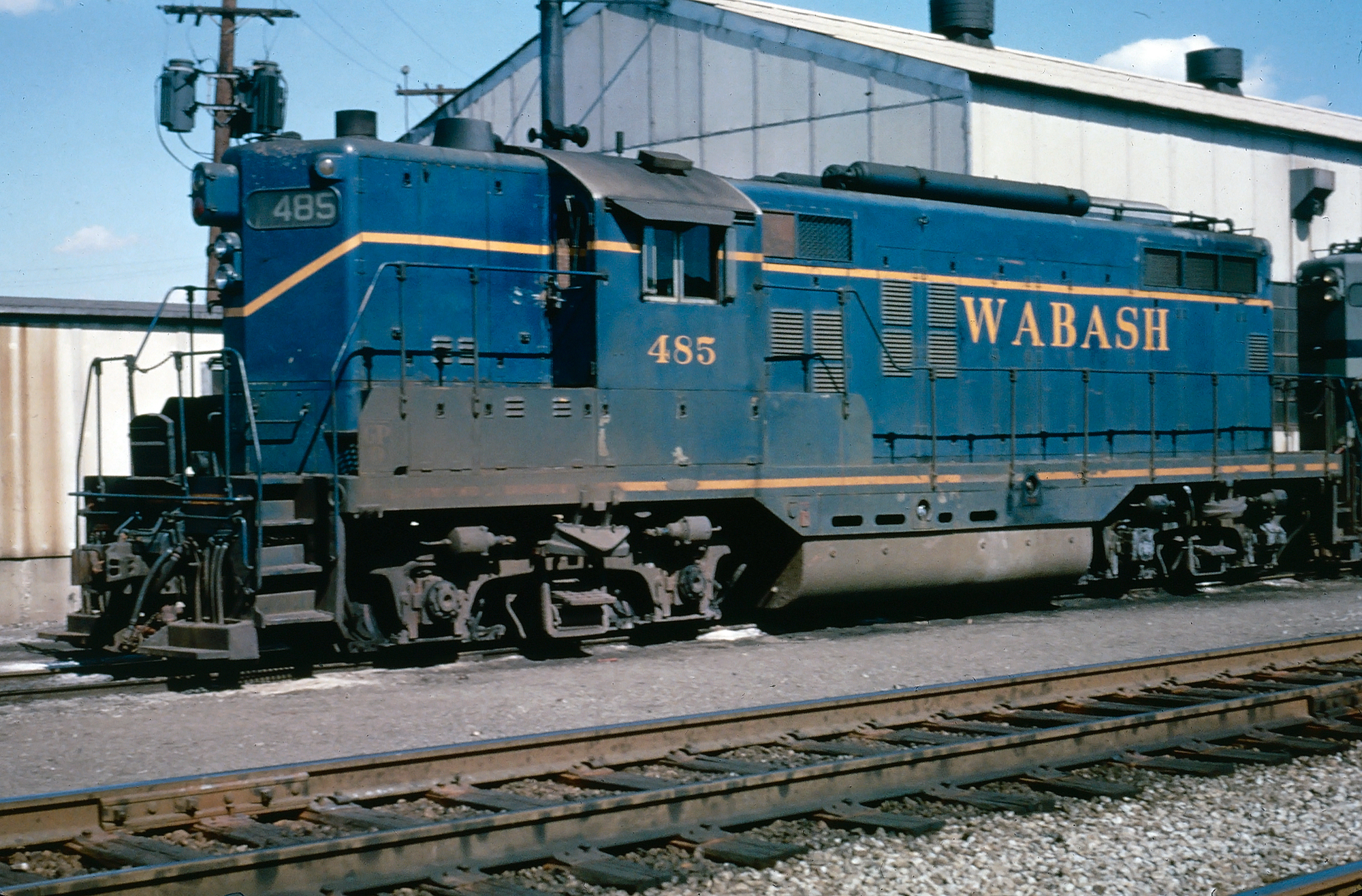 Wabash GP9 #485 was photographed here at the road's engine terminal in Melvindale, Michigan on March 15, 1964. Photographer unknown. American-Rails.com collection.
Wabash GP9 #485 was photographed here at the road's engine terminal in Melvindale, Michigan on March 15, 1964. Photographer unknown. American-Rails.com collection.Diesel Roster
Alco
| Builder | Model | Original Number(s) | Class | Norfolk & Western Number | Serial Number | Completion Date | Disposition |
|---|---|---|---|---|---|---|---|
| Alco | HH600 | 100, 150 | D-6 | - | 69083, 69254 | 4/1939, 3/1940 | Scrapped: 4/1966, 12/1966 |
| Alco | S1 | 1 (Acquired 1/1962) | D-6 | - | 69190 | 5/1940 | Ex-Des Moines Union #1, scrapped 10/1962. |
| Alco | S1 | 2 (Acquired 1961) | D-6 | - | 69196 | 6/1940 | Ex-New Jersey, Indiana & Illinois Railroad #1, scrapped 12/1966. |
| Alco | S1 | 151-152 | D-6 | - | 69495, 69607 | 7/1941, 1/1942 | Retired, 11/1966-12/1966. |
| Alco | S1 | 153 | D-6 | - | 72695 | 9/1944 | Sold to Precision Engine Company in 1966. |
| Alco | S1 | 154 | D-6 | - | 72696 | 9/1944 | Retired, 9/1966. |
| Alco | S1 | 155 | D-6 | - | 72839 | 9/1944 | Retired, 5/1966. |
| Alco | S1 | 156 | D-6 | - | 75127 | 2/1947 | Sold, 3/1962, to Birmingham Rail & Locomotive Company. |
| Alco | S1 | 157 | D-6 | - | 75128 | 2/1947 | Retired, 9/1966. |
| Alco | S1 | 158 | D-6 | - | 75646 | 3/1948 | Sold, 3/1962, to Birmingham Rail & Locomotive Company. |
| Alco | S1 | 159 | D-6 | - | 75647 | 3/1948 | Sold, 3/1962, to Birmingham Rail & Locomotive Company. |
| Alco | S2 | 310 | D-10 | - | 69910 | 8/1942 | Retired, 7/1966. |
| Alco | S2 | 311 | D-10 | - | 69911 | 8/1942 | Retired, 12/1966. |
| Alco | S2 | 312 | D-10 | - | 70226 | 11/1943 | Retired, 1966. |
| Alco | S2 | 313 | D-10 | - | 70245 | 4/1944 | Retired, 11/1966. |
| Alco | S2 | 314 | D-10 | - | 70201 | 4/1944 | Retired, 4/1967. |
| Alco | S2 | 315 | D-10 | - | 70202 | 3/1944 | Retired, 9/1968. |
| Alco | S2 | 316 | D-10 | - | 72063 | 6/1944 | Retired, 11/1966. |
| Alco | S2 | 317 | D-10 | - | 72064 (Alco's 1000th diesel completed.) | 6/1944 | Retired, 7/1966. |
| Alco | S2 | 318 | D-10 | - | 74491 | 7/1946 | Retired, 12/1966. |
| Alco | S2 | 319 | D-10 | - | 74492 | 7/1946 | - |
| Alco | S2 | 320 | D-10 | 3320 | 76762 | 5/1949 | - |
| Alco | S2 | 321 | D-10 | 3321 | 76763 | 5/1949 | - |
| Alco | S4 | 322 | D-10 | 3322 | 80610 | 6/1953 | - |
| Alco | S4 | 323 | D-10 | 3323 | 80611 | 6/1953 | - |
| Alco | S4 | 324 | D-10 | 3324 | 80612 | 6/1953 | - |
| Alco | S2 | 325 | D-10 | - | 69928 | 7/1942 | Former Nickel Plate Road #5 acquired in 5/1964. Retired 3/1966. |
| Alco | FB-1 | 1200B-1204B | D-15 | 800-804: Renumbered 1961 | 76712, 76724-76726, 76866 | 2/1949-3/1949 | Traded to GE between 3/1962-4/1962. Trucks reused on new U25Bs. |
| Alco | FA-1 | 1200-1204 | D-15 | 805-813 (Odds): Renumbered 1961 | 76664, 76696, 76698, 76700, 76702 | 1/1949-3/1949 | Traded to GE between 3/1962-4/1962. Trucks reused on new U25Bs. |
| Alco | FA-1 | 1200A-1204A | D-15 | 806-814 (Evens): Renumbered 1961 | 76665, 76697, 76699, 76701, 76703 | 1/1949-3/1949 | Traded to GE between 3/1962-4/1962. Trucks reused on new U25Bs. |
| Alco | FA-2 | 820-823 | D-16 | - | 78384, 78480, 78380, 78479 | 12/1950 | Ex-Ann Arbor #52A, #55A, #50A, and #55. Acquired in 1963 and traded to Alco in 7/1965. |
| Alco | PA-2 | 1020, 1020A, 1021, 1021A | D-20 | 1050-1053 (1961 renumbering) | 77081-77084 | 5/1949 | - |
| Alco | C424 | B900-B906 | D-24 | 3900/421-3901/422, 3903/423-3906/426 | 3372-01 thru 3372-07 | 3/1964 | B902 wrecked in 10/1964, scrapped. |
* Wabash ordered C425s as #582-589 but these units were completed as Norfolk & Western 1000-1007.
Baldwin Locomotive Works
| Builder | Model | Original Number(s) | Class | Norfolk & Western Number | Serial Number | Completion Date | Disposition |
|---|---|---|---|---|---|---|---|
| Baldwin | VO660 | 200 | D-6 | - | 62497 | 7/1941 | Leased to the Lake Erie & Fort Wayne Railroad (#1) in 1965. Retired 5/1968. |
| Baldwin | DS-4-4-660 | 201 | D-6 | - | 73363 | 2/1947 | Retired 3/1964. |
| Baldwin | DS-4-4-660 | 202 | D-6 | - | 73364 | 3/1947 | Retired 3/1964. |
| Baldwin | VO-1000 | 300 | D-10 | - | 64425 | 9/1942 | Retired 3/1964. |
| Baldwin | VO-1000 | 301 | D-10 | - | 70151 | 2/1944 | Retired 3/1964. |
| Baldwin | VO-1000 | 302 | D-10 | - | 70152 | 2/1944 | Retired 9/1966. |
| Baldwin | VO-1000 | 303 | D-10 | - | 72229 | 6/1946 | Retired 11/1966. |
| Baldwin | DS-4-4-1000 | 304 | D-10 | - | 73955 | 1/1949 | Wrecked and rebuilt into cabless booster. Retired 3/1964. |
EMD
| Builder | Model | Original Number(s) | Class | Norfolk & Western Number | Serial Number | Completion Date | Disposition | |
|---|---|---|---|---|---|---|---|---|
| EMC | SW1 | 101 | D-6 | - | 880 | 4/1939 | Sold to Peabody Coal Company (#101) in 1960. | |
| EMC | SW1 | 102 | D-6 | - | 881 | 6/1939 | Sold to Bonhomie & Hattiesburg Southern (#2) in 10/1961. | |
| EMC | SW1 | 103 | D-6 | - | 882 | 6/1939 | Sold to Bonhomie & Hattiesburg Southern (#1) in 10/1961. | |
| EMD | SW1 | 104 | D-6 | - | 1024 | 2/1940 | Sold to Peabody Coal Company (#104) in 7/1960. | |
| EMD | SW1 | 105 | D-6 | - | 1075 | 5/1940 | Sold to Tulsa-Sapulpa Union Railway (#105) in 3/1960. | |
| EMD | SW1 | 106 | D-6 | - | 1197 | 11/1940 | Sold to Granite City Steel (#106) in 7/1961. | |
| EMD | SW1 | 107 | D-6 | - | 1388 | 11/1945 | Sold to Granite City Steel (#602) in 8/1961. | |
| EMD | SW1 | 108 | D-6 | - | 4730 | 4/1947 | Sold to Tulsa-Sapulpa Union Railway (#108) in 4/1964. | |
| EMD | SW1 | 109 | D-6 | 3109 | 7533 | 6/1949 | - | |
| EMD | SW1 | 110 | D-6 | 3110 | 7741 | 6/1949 | Sold to the Anderson Corporation (Bayport, Minnesota). | |
| EMD | SW1 | 111 | D-6 | - | 7742 | 6/1949 | Sold to Granite City Steel (#111) in July, 1964. | |
| EMD | SW8 | 120 | D-8 | 3120 | 9045 | 10/1950 | - | |
| EMD | SW8 | 121 | D-8 | 3121 | 9046 | 10/1950 | - | |
| GMD | SW8 | 122 | D-8 | 3122 | A-145 | 12/1950 | - | |
| GMD | SW8 | 123 | D-8 | 3123 | A-146 | 12/1950 | - | |
| GMD | SW8 | 124 | D-8 | 3124 | A-147 | 1/1951 | - | |
| EMD | SW8 | 125 | D-8 | 3125 | 14418 | 9/1951 | - | |
| EMD | SW8 | 126 | D-8 | 3126 | 14419 | 9/1951 | - | |
| GMD | SW8 | 127 | D-8 | 3127 | A-278 | 1/1951 | - | |
| EMD | SW8 | 128 | D-8 | 3128 | 17589 | 2/1953 | - | |
| EMD | SW8 | 129 | D-8 | 3129 | 17590 | 2/1953 | - | |
| EMD | SW8 | 130 | D-8 | 3130 | 17591 | 2/1953 | - | |
| EMD | SW8 | 131 | D-8 | 3131 | 17592 | 2/1953 | - | |
| EMD | SW8 | 132 | D-8 | 3132 | 17593 | 2/1953 | - | |
| EMD | NW2 | 346 | D-10 | - | 1423 | 8/1941 | Ex-Nickel Plate Road #98, nee-Wheeling & Lake Erie #D-4 | |
| EMD | NW2 | 347 | D-10 | - | 998 | 4/1940 | Ex-Nickel Plate Road #95, nee-Wheeling & Lake Erie #D-1 | |
| EMD | NW2 | 348 | D-10 | 3348 | 1089 | 7/1940 | Ex-Nickel Plate Road #96, nee-Wheeling & Lake Erie #D-2. Sold to Island Creek Coal in 3/1968. | |
| EMD | NW2 | 349 | D-10 | 3349 | 1422 | 6/1941 | Ex-Nickel Plate Road #97, nee-Wheeling & Lake Erie #D-3. Sold to the Celanese Company in 10/1966. | |
| EMD | NW2 | 350 | D-10 | 3350 | 4159 | 12/1946 | Transferred to Des Moines Union (#7) in 10/1966. | |
| EMD | NW2 | 351 | D-10 | 3351 | 7531 | 7/1949 | - | |
| EMD | NW2 | 352 | D-10 | 3352 | 7532 | 7/1949 | - | |
| EMD | NW2 | 353 | D-10 | - | 7531 | 5/1948 | Built as Indiana Northern #100; sold to New Jersey, Indiana & Illinois Railroad (#2) in 1961. | |
| EMD | SW7 | 355-362 | D-12 | 3355-3362 | 9037-9044 | 7/1950 | - | |
| EMD | SW9 | 363-374 | D-12 | 3363-3374 | 12622-12625, 15058-15062, 17580-17582 | 4/1951-3/1953 | - | |
| EMD | SW1200 | 375-379 | D-12 | 3375-3379 | 18877-18880, 23297 | 1/1957 | - | |
| EMD | GP7 | 450-452 | D-15 | 3450-3452 | 11993-11995 | 8/1950-9/1950 | - | |
| GMD | GP7 | 453 | D-15 | 3453 | A-148 | 1/1951 | - | |
| EMD | GP7 | 454 | D-15 | - | 14408 | 7/1951 | Wrecked 8/1959. Scrapped 6/1960. | |
| EMD | GP7 | 455-483 | D-15 | 3455-3483 | 14409-14417, 15048-15057, 17080, 17076, 17077-17079, 17571-17575 | 7/1951-1/1953 | - | |
| EMD | GP9 | 484-495 | D-17 | - | 3484-3495 | 1/1954-4/1956 | - | |
| EMD | GP35 | 540-547 | D-25 | 3540/2911-3547/2918 | 29468-29469, 29471-29476 | 4/1964 | - | |
| EMD | GP35 | (548-554) | D-25 | 1302-1308 | 29658-29664 | 11/1964 | Ordered as Wabash 548-554 and completed as N&W 1302-1308. | |
| EMD | E7A | 1000, 1001A, 1001-1002 | D-20 | - | 3226, 4085, 4084, 6499 | 8/1946-3/1949 | #1000 renumbered 1002A then as #1017 in 1961. #1001A renumbered 1016 in 1961. | |
| EMD | E8A | 1000, 1003-1015 | D-20 | 3800, 3803-3812, 3815 | 15063, 7812-7817, 14420-14424, 17565-17566 | 11/1949-1/1953 | #1013-1014 wrecked in 8/1961. | |
| EMD | F7B | 1100B-1108B | D-15 | 600-608: Renumbered 1961 | 7616-7618, 7621, 7615, 7628-7630, 11295 | 8/1949-6/1950 | - | |
| EMD | F7A | 1100-1108 | D-15 | 609-625 (Odds): Renumbered 1961 | 7609, 7611, 7613, 7619, 7607, 7622, 7624, 7626, 9061 | 8/1949-6/1950 | #1101B sold to Ann Arbor in 10/1963. | |
| EMD | F7A | 1100A-1108A | D-15 | 610-626 (Evens): Renumbered 1961 | 7610, 7612, 7614, 7620, 7608, 7623, 7625, 7627, 9062 | 8/1949-6/1950 | #1102A and #1105A sold to Ann Arbor in 10/1963. | |
| EMD | F7A | 1140-1154 | D-15 | 627-655 (Odds): Renumbered 1961 | 9047-9073 (Odds), 11293, 12305 | 6/1950-7/1950 | - | |
| EMD | F7A | 1140A-1154A | D-15 | 628-656 (Evens): Renumbered 1961 | 9048-9074 (Evens), 11294, 12306 | 6/1950-7/1950 | - | |
| GMD | F7A | 1155-1158 | D-15 | 657-663 (Odds): Renumbered 1961 | A125-A131 (Odds) | 12/1950-1/1951 | - | |
| GMD | F7A | 1155A-1157A | D-15 | 658-662 (Evens): Renumbered 1961 | A126-A130 (Evens) | 12/1950 | - | |
| GMD | F7A | 1159-1164 | D-15 | 665-675 (Odds): Renumbered 1961 | A133-A143 (Odds) | 1/1951 | - | |
| GMD | F7A | 1158A-1164A | D-15 | 664-676 (Evens): Renumbered 1961 | A132-A144 (Evens) | 1/1951 | - | |
| EMD | F7A | 1165-1188 | D-15 | 677-723 (Odds): Renumbered 1961 | 9020-9036 (Evens), 12613-12617 (Odds), 15036-15046 (Evens), 17068-17074 (Evens), 17576-17578 (Evens) | 6/1951-1/1953 | See Note A. | |
| EMD | F7A | 1165A-1188A | D-15 | 678-724 (Evens): Renumbered 1961 | 9021-9035 (Odds), 12612-12618 (Evens), 15037-15047 (Odds), 17069-17075 (Odds), 17577-17579 (Odds) | 6/1951-1/1953 | See Note A. | |
| GMD | F7A | 1189-1189A | D-15 | 725-726: Renumbered 1961 | A-487, A-488 | 4/1953 | - | |
| EMC | Doodlebug | 4000-4001 | - | - | 140, 139 | 2/1926, 1/1926 | 4000 rebuilt into MOW car 4297 in 1937. 4001 sold to Consolidated Railway Equipment in 1956. |
Note A:
- #1168, #1170, and #1180A wrecked in 4/1965.
- #1172A wrecked, and then scrapped in 11/1959. This unit would have became #692.
- #1183 sold to Ann Arbor in 11/1963.
- #689-690, #697, #703, #705, #712, #714-#715, and #717-718 leased to CNJ.
Fairbanks-Morse
| Builder | Model | Original Number(s) | Class | Norfolk & Western Number | Serial Number | Completion Date | Disposition |
|---|---|---|---|---|---|---|---|
| FM | H10-44 | 380 | D-10 | 3380 | L1021 | 11/1946 | Retired 3/1966. |
| FM | H10-44 | 381 | D-10 | 3381 | L1022 | 11/1946 | Retired 6/1966. |
| FM | H10-44 | 382 | D-10 | 3382 | 10L101 | 3/1949 | Retired 1970. |
| FM | H10-44 | 383 | D-10 | 3383 | 10L102 | 3/1949 | Retired 6/1966. |
| FM | H12-44 | 384-386 | D-12 | 3384-3386 | 12L744-12L746 | 3/1953 | Retired 1970-1971. |
| FM | H24-66 (Train Master) | 550-551 (ex-Demonstrators TM-1 and TM-2) | D-24 | 3598-3599 | 24L730-24L731 | 4/1953 | Renumbered 598-599 in 1964. |
| FM | H24-66 (Train Master) | 552/552A, 553/553A, 554/554A | D-24 | 3592-3597 | 24L891-24L896 | 4/1956-5/1956 | Renumbered 592, 595, 593, 596, 594, 597 between 1961-1964. |
General Electric
| Builder | Model | Original Number(s) | Class | Norfolk & Western Number | Serial Number | Completion Date | Disposition |
|---|---|---|---|---|---|---|---|
| GE | 44-Ton | 51 | D-3 | - | 12496 | 7/1939 | Sold to Merrilees Equipment Company in 1961. |
| GE | U25B | 500-503 | D-25 | 3529/8152, 3522/8145, 3520/8143, 3518/8141 | 34254, 34522, 34256-34257 | 5/1962-8/1962 | - |
| GE | U25B | 504-514 | D-25 | 3517/8140, 3524/8147, 3526/8149, 3523/8146, 3521/8144, 3516/8139, 3525/8148, 3528/8151, 3519/8142, 3527/8150 | 34258-34259, 34519-34521, 34524, 34523, 34525-34527, 34255 | 5/1962-8/1962 | 512 wrecked in 10/1964, scrapped. |
| GE | U25B | 512 (2nd) | D-25 | 3515/8138 | 35581 | 2/1965 | Replaced original 512. |
Lima-Hamilton
| Builder | Model | Original Number(s) | Class | Norfolk & Western Number | Serial Number | Completion Date | Disposition |
|---|---|---|---|---|---|---|---|
| LH | 1000 HP Switcher | 400 (ex-Demonstrator #1002, rebuilt to 1,200 horsepower) | D-10 | - | 9395 | 3/1950 | - |
| LH | 1200 HP Switcher | 401 | D-12 | - | 9417 | 4/1950 | Rebuilt 1,200 horsepower Alco engine. Retired 10/1965. |
| LH | 1200 HP Switcher | 402 | D-12 | - | 9418 | 4/1950 | Rebuilt 1,200 horsepower Alco engine. Retired 5/1965. |
| LH | 1200 HP Switcher | 403 | D-12 | - | 9419 | 4/1950 | Rebuilt 1,200 horsepower Alco engine. Retired 2/1966. |
| LH | 1200 HP Switcher | 404 | D-12 | - | 9420 | 5/1950 | Rebuilt 1,200 horsepower Alco engine. Retired 2/1966. |
| LH | 1200 HP Switcher | 405 | D-12 | - | 9421 | 5/1950 | Rebuilt 1,200 horsepower Alco engine. Retired 2/1966. |
| LH | 1200 HP Switcher | 406 | D-12 | - | 9422 | 5/1950 | Rebuilt 1,200 horsepower Alco engine. Retired 2/1966. |
| LH | 1200 HP Switcher | 407 (Ex-Demonstrator #1003) | D-12 | - | 9397 | 8/1950 | Rebuilt 1,200 horsepower Alco engine. Retired 2/1966. |
| LH | 1200 HP Switcher | 408 | D-12 | - | 9508 | 11/1950 | Rebuilt 1,200 horsepower Alco engine. Retired 9/1965. |
| LH | 1200 HP Switcher | 409 | D-12 | - | 9509 | 11/1950 | Rebuilt 1,200 horsepower Alco engine. Retired 7/1965. |
| LH | 1200 HP Switcher | 410 | D-12 | - | 9510 | 11/1950 | Rebuilt 1,200 horsepower Alco engine. Retired 7/1965. |
| LH | 1200 HP Switcher | 411 | D-12 | - | 9511 | 11/1950 | Rebuilt 1,200 horsepower Alco engine. Retired 2/1966. |
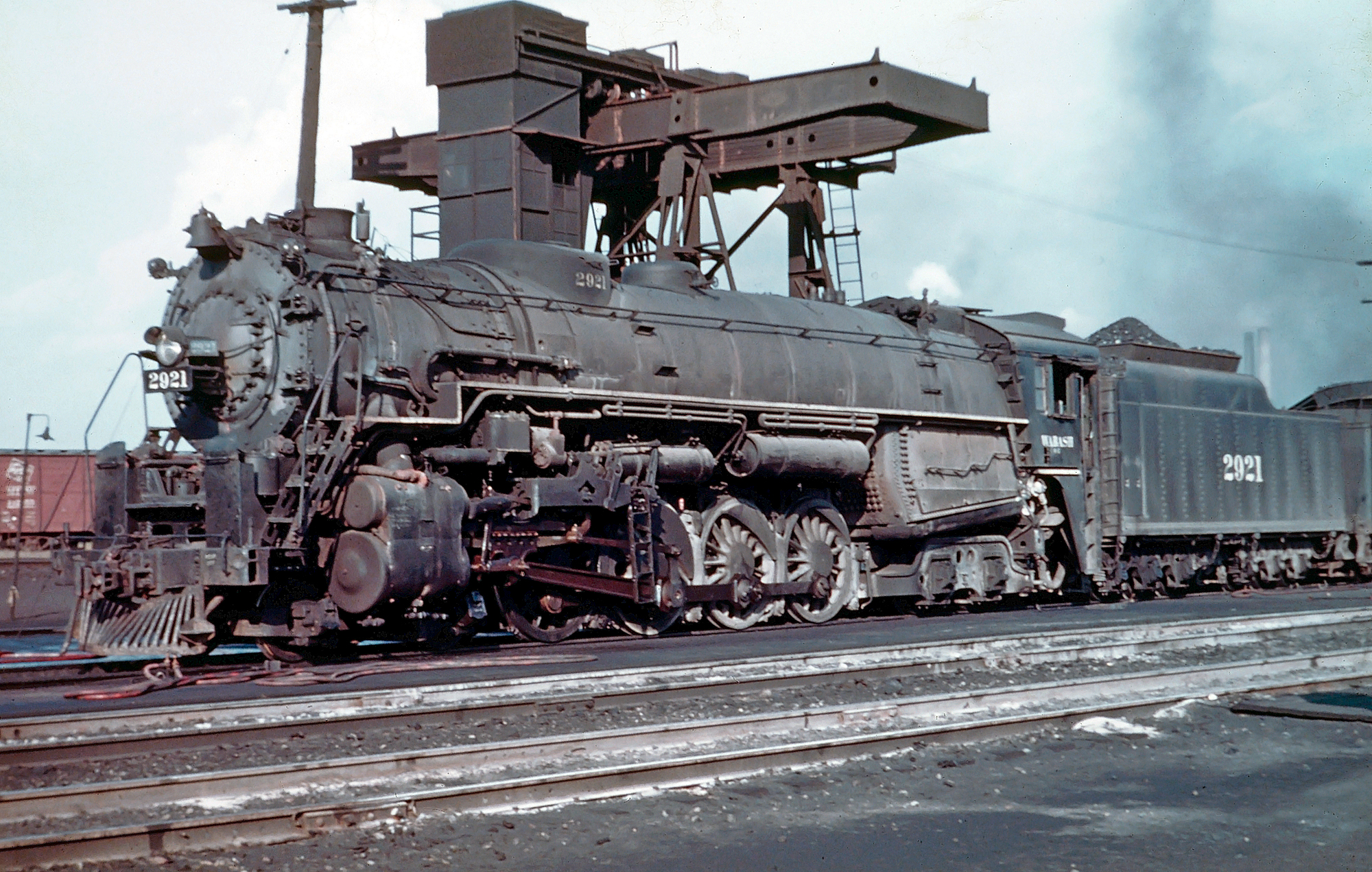 Wabash 4-8-4 #2921 at Decatur, Illinois, circa 1951. Like most examples of this wheel arrangement built for other lines, the railroad employed them in fast freight assignments. The fleet of twenty-five units (#2900-2924), listed as Class O1, was manufactured by Baldwin in 1930 and remained in service until the mid-1950s. This particular unit operated until December, 1951 and was later sold for scrap to Luria Brothers in November, 1955. Fred Byerly photo. American-Rails.com collection.
Wabash 4-8-4 #2921 at Decatur, Illinois, circa 1951. Like most examples of this wheel arrangement built for other lines, the railroad employed them in fast freight assignments. The fleet of twenty-five units (#2900-2924), listed as Class O1, was manufactured by Baldwin in 1930 and remained in service until the mid-1950s. This particular unit operated until December, 1951 and was later sold for scrap to Luria Brothers in November, 1955. Fred Byerly photo. American-Rails.com collection.All-Time Steam Locomotive Roster After 1897 (Abbreviated)
Switchers
| Road Number(s) | Class | Arrangement | Builder | Date Built/Notes |
|---|---|---|---|---|
| 78-81 | A-1 | 0-4-0 | Toledo, Wabash & Western | 1871 |
| 356-358 | A-2 | 0-4-0 | Pittsburgh | 6/1880 |
| 2 | A-3 | 0-4-0 | Moberly Shops | 1888 |
| 7, 11, 15, 28, 30, 34-37 | A-3 | 0-4-0 | Wabash Railroad | 1881-1887 |
| 40, 54, 56-57, 80-81 | A-3 | 0-4-0 | Wabash Railroad | 1884-1891 |
| 103, 106, 112, 114-117 | A-3 | 0-4-0 | Wabash Railroad | 1883-1889 |
| 119-120, 157, 159, 178 | A-3 | 0-4-0 | Wabash Railroad | 1887-1889 |
| 192-194 | A-3 | 0-4-0 | Wabash Railroad | 1880-1883 |
| 218, 223 | B-1 | 0-6-0 | Wabash, St. Louis & Pacific | 1880-1882 |
| 4, 22, 32, 105,108-111 | B-2 | 0-6-0 | Rhode Island | 10/1888-6/1891 |
| 146, 162, 197-198, 202 | B-2 | 0-6-0 | Rhode Island | 4/1892 |
| 215, 228, 431-435 | B-2 | 0-6-0 | Rhode Island | 10/1888-12/1892 |
| 268-276 | B-3 | 0-6-0 | Rebuilt From 2-6-0's (F-2) | - |
| 300 | B-3 | 0-6-0 | Pittsburgh | 2/1898 |
| 1219-1222, 219-222 | B-4 | 0-6-0 | Rhode Island | 3/1889-4/1889 |
| 501-504 | B-5 | 0-6-0 | Rhode Island | 11/1899 |
| 505-508 | B-5 | 0-6-0 | Alco/Richmond | 1901 |
| 509-524 | B-6 | 0-6-0 | Baldwin | 10/1903-6/1904 |
| 525-536, 547-554 | B-7 | 0-6-0 | Rhode Island | 8/1906-10/1906 |
| 537-546, 555-566 | B-7 | 0-6-0 | Baldwin | 9/1907-5/1912 |
| 481-499 | B-8 | 0-6-0 | Wabash Railroad | 1/1917-1923 |
| 1501-1502 | C-1 | 0-8-0 | Rebuilt From 2-8-0's (I-2) | 12/1917 |
| 1520-1521 | C-2 | 0-8-0 | Alco/Brooks | 9/1920 |
| 1525-1544 | C-3 | 0-8-0 | Alco | 9/1923 |
| 1545-1569 | C-4 | 0-8-0 | Lima | 3/1923-4/1926 |
Freight Locomotives
| Road Number(s) | Class | Arrangement | Builder | Date Built/Notes |
|---|---|---|---|---|
| 1016-1017, 1024-1025 | F-1 | 2-6-0 | Rome | 11/1884-12/1884 |
| 1133-1138, 1143 | F-1 | 2-6-0 | Rome | 12/1884-1/1885 |
| 1005, 1025, 1029, 1032 | F-2 | 2-6-0 | Baldwin | 10/1884-11/1884 |
| 1101-1102, 1104, 1107 | F-2 | 2-6-0 | Baldwin | 11/1884 |
| 1113, 1187, 1204, 1214 | F-2 | 2-6-0 | Baldwin | 11/1884 |
| 1225, 1576 | F-2 | 2-6-0 | Baldwin | 12/1884 |
| 225 | F-3 | 2-6-0 | Baldwin | Rebuilt From #1225 |
| 582, 569, 588, 583 | F-4 | 2-6-0 | Rhode Island | 9/1899-10/1899 |
| 574-575, 580, 584, 587 | F-4 | 2-6-0 | Rhode Island | 9/1899-10/1899 |
| 585, 589-590 | F-4 | 2-6-0 | Rhode Island | 10/1899 |
| 576, 578, 581 | F-4 | 2-6-0 | Richmond | 1899 |
| 591-594 | F-4 | 2-6-0 | Richmond | 1899 |
| 596-599 | F-4 | 2-6-0 | Baldwin | 7/1899-9/1899 |
| 586, 579, 573 | F-5 | 2-6-0 | Rhode Island | 10/1899-11/1899 |
| 571 | F-5 | 2-6-0 | Richmond | 1899 |
| 801-834 | F-6 | 2-6-0 | Alco/Richmond | 1901 |
| 835-866 | F-6 | 2-6-0 | Alco/Richmond | 7/1903-11/1903 |
| 867-903*** | F-7 | 2-6-0 | Baldwin | 6/1904-7/1904 |
| 2001-2030 | G-1 | 2-6-2 | Baldwin | 8/1906-9/1906 |
| 2031-2090 | G-1 | 2-6-2 | Alco/Rogers | 9/1907-11/1907 |
| 266-267** | I-1 | 2-8-0 | Rhode Island | 11/1895-1/1896 |
| 2150-2166 | I-2 | 2-8-0 | Alco/Brooks | 8/1905 |
| 2301-2330**** | I-3 | 2-8-0 | Baldwin | 9/1906-11/1906 |
| 2170-2178 | I-4 | 2-8-0 | Alco | 10/1908 |
| 2180-2183 | I-5 | 2-8-0 | Alco | 12/1909 |
| 2350-2352 | I-6 | 2-8-0 | Alco/Brooks | 1912 |
| 2139-2142 | I-7 | 2-8-0 | Baldwin | 7/1895-12/1895 |
| 2375 | I-8 | 2-8-0 | Baldwin | 2/1892 |
| 2401-2415 | K-1 | 2-8-2 | Alco/Richmond | 2/1912 |
| 2416-2443 | K-1 | 2-8-2 | Baldwin | 5/1912-6/1912 |
| 2444-2463 | K-1 | 2-8-2 | Alco/Pittsburgh | 12/1912 |
| 2201-2220 | K-2 | 2-8-2 | Alco | 11/1918 |
| 2213-2215, 2218-2219 | K-2 | 2-8-2 | Baldwin | 12/1918****** |
| 2250-2274 | K-3 | 2-8-2 | Alco | 12/1923 |
| 2275-2279 | K-3b | 2-8-2 | Alco | 12/1923 |
| 2700-2719 | K-4b | 2-8-2 | Alco | 2/1925 |
| 2720-2744 | K-4 | 2-8-2 | Alco | 1/1925 |
| 2600-2604 | K-5 | 2-8-2 | Alco | 2/1925 |
| 2480-2482 | K-6 | 2-8-2 | Alco/Brooks | 12/1916 |
| 2490-2494 | K-7 | 2-8-2 | Alco/Brooks | 7/1923-10/1923 |
| 2501-2525 | L-1 | 2-10-2 | Alco/Brooks | 7/1917 |
| 2550-2553 | L-2 | 2-10-2 | Baldwin | 9/1919 |
| 2900-2924 | O-1 | 4-8-4 | Baldwin | 8/1930-1/1931 |
Passenger Locomotives
| Road Number(s) | Class | Arrangement | Builder | Date Built/Notes |
|---|---|---|---|---|
| 601-605 (1st) | E-1 | 4-4-2 | Baldwin | 3/1898 |
| 606-611 (1st) | E-2 | 4-4-2 | Alco/Richmond | 1901 |
| 612-623 | E-3 | 4-4-2 | Alco/Brooks | 1903 |
| 602-611 (2nd) | E-4 | 4-4-2 | Baldwin | 7/1904 |
| 1610-1613 | E-5 | 4-4-2 | Alco | 11/1907 |
| 1614 | E-6 | 4-4-2 | Alco | 6/1909 |
| 376-381 | H-1 | 4-6-0 | Rogers | 2/1881-3/1881 |
| 390, 1351, 1353, 1354 | H-2 | 4-6-0 | Rhode Island | 6/1880-1/1881 |
| 1383, 1481, 1563 | H-2 | 4-6-0 | Rhode Island | 12/1880-3/1882 |
| 8-9, 27, 203, 205, 229 | H-3 | 4-6-0 | Wabash, St. Louis & Pacific | 1887-1889 |
| 246-247 | H-3 | 4-6-0 | Wabash, St. Louis & Pacific | 1887 |
| 23, 95, 1144-1145 | H-4 | 4-6-0 | Springfield Shops | 1890-9/1891 |
| 257-261** | H-5 | 4-6-0 | Baldwin | 12/1898 |
| 345-350, 1351, 352 | H-6 | 4-6-0 | Rhode Island | 2/1880-6/1880 |
| 1353-1354, 355, 382 | H-6 | 4-6-0 | Rhode Island | 6/1880-12/1880 |
| 1383, 384-391, 477-480 | H-6 | 4-6-0 | Rhode Island | 12/1880-7/1881 |
| 1481, 482, 556-562, 1563 | H-6 | 4-6-0 | Rhode Island | 3/1882 |
| 5, 26, 29, 58, 101-102, 107 | H-7 | 4-6-0 | Rhode Island | 6/1890 |
| 113, 123, 141, 147, 158, 160 | H-7 | 4-6-0 | Rhode Island | 9/1890-9/1891 |
| 714-720 | H-7 | 4-6-0 | Richmond | 1898 |
| 164, 168, 172, 233-236 | H-7 | 4-6-0 | Rhode Island | 9/1891-5/1892 |
| 423-430 | H-7 | 4-6-0 | Rhode Island | 9/1892 |
| 347, 391 | H-8 | 4-6-0 | Moberly Shops | 6/1899, 8/1899 |
| 701-705 | H-9 | 4-6-0 | Baldwin | 3/1898 |
| 706-710 | H-9 | 4-6-0 | Pittsburgh | 3/1898 |
| 711 | H-9 | 4-6-0 | Pittsburgh | 1898 |
| 712-713 | H-10 | 4-6-0 | Richmond | 1898 |
| 1630-1635 | H-11 | 4-6-0 | Alco/Richmond | 1901 |
| 636-645 | H-12 | 4-6-0 | Baldwin | 8/1904 |
| 660-669 | J-1 | 4-6-2 | Alco/Richmond | 2/1912 |
| 670-675 | J-1 | 4-6-2 | Baldwin | 5/1912 |
| 1676-1681***** | J-2 | 4-6-2 | Wabash Railway | 10/1916-12/1917 |
| 683-699***** | J-2 | 4-6-2 | Wabash Railway | 5/1916-11/1926 |
| 700-706 | P-1 | 4-6-4 | Decatur Shops | 8/1943-1947 |
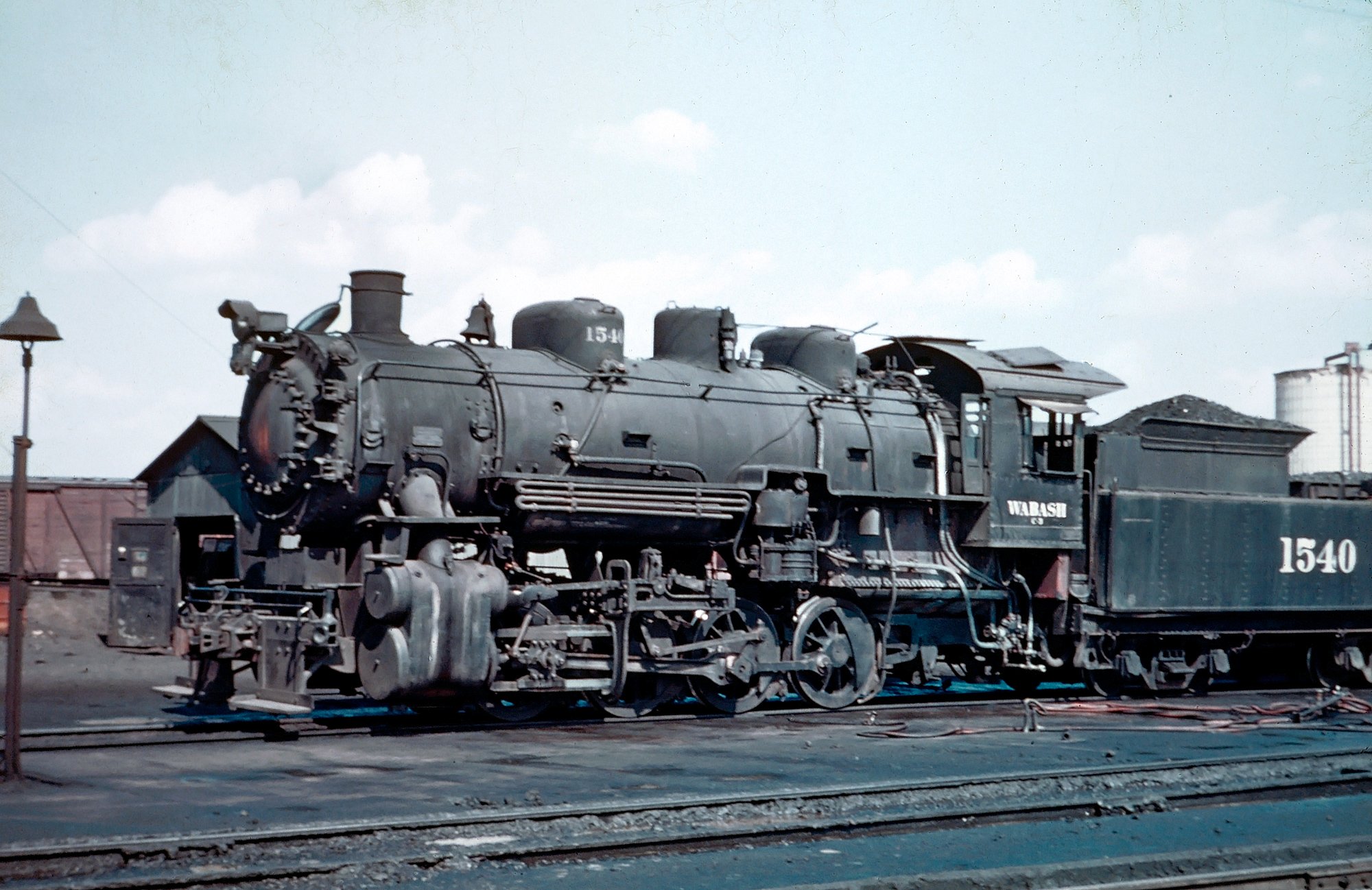 One of the Wabash's Class C-3 0-8-0 switchers, #1540, is seen here in Decatur, Illinois, circa 1950. Fred Byerly photo. American-Rails.com collection.
One of the Wabash's Class C-3 0-8-0 switchers, #1540, is seen here in Decatur, Illinois, circa 1950. Fred Byerly photo. American-Rails.com collection.Dual Service
| Road Number(s) | Class | Arrangement | Builder | Date Built/Notes |
|---|---|---|---|---|
| 253-254* | D-1 | 4-4-0 | W.H. Bailey | 12/1877-2/1878 |
| 18 ("Camilla") | D-2 | 4-4-0 | Mason | 8/1855 |
| 55 ("Maumee") | D-2 | 4-4-0 | Mason | 6/1866 |
| 238-240 | D-2 | 4-4-0 | Mason | 4/1867-5/1867 |
| 83-87, 90-91 | D-3 | 4-4-0 | Rogers | 7/1871 |
| 257-265 | D-3 | 4-4-0 | Rogers | 2/1868-9/1869 |
| 273-288 | D-3 | 4-4-0 | Rogers | 2/1870-4/1870 |
| 368-370 | D-3 | 4-4-0 | Rogers | 5/1873 |
| 59-62, 64-68 | D-4 | 4-4-0 | Pittsburgh | 8/1869-3/1871 |
| 70, 72, 76 | D-4 | 4-4-0 | Pittsburgh | 4/1871-5/1871 |
| 186, 189-191 | D-4 | 4-4-0 | Pittsburgh | 7/1873-8/1873 |
| 173, 179-180 | D-5 | 4-4-0 | Schenectady | 8/1871 |
| 199 | D-6 | 4-4-0 | Cooke | 9/1873 |
| 98-100 | D-7 | 4-4-0 | Mason | 4/1872 |
| 163, 169-170 | D-7 | 4-4-0 | Mason | 4/1871-6/1871 |
| 201 | D-7 | 4-4-0 | Mason | 5/1872 |
| 241-244, 248-249 | D-7 | 4-4-0 | Mason | 5/1867-8/1867 |
| 359-363 | D-8 | 4-4-0 | Hinkley | 1880 |
| 181, 183 | D-9 | 4-4-0 | Pittsburgh | 8/1873 |
| 46 ("John Rose") | D-10 | 4-4-0 | Mason | 7/1863 |
| 155-156 | D-10 | 4-4-0 | Mason | 8/1870-9/1870 |
| 97, 188 | D-11 | 4-4-0 | Pittsburgh | 1/1872-7/1873 |
| 73, 75, 410 | D-12 | 4-4-0 | Wabash Railway | 1879 |
| 1082 | D-12 | 4-4-0 | Rome | 1885 |
| 88-89, 20, 167 | D-12 | 4-4-0 | Wabash, St. Louis & Pacific | 1885-1886 |
| 230 ("Hercules") | D-13 | 4-4-0 | Schenectady | 9/1860 |
| 232 ("US Grant") | D-13 | 4-4-0 | Schenectady | 1/1865 |
| 49/1049, 53/1053 | D-14 | 4-4-0 | Wabash Railway | 1878-1879 |
| 245/1245 | D-15 | 4-4-0 | Wabash Railway | 1879 |
| 226-227, 231 | D-16 | 4-4-0 | Schenectady | 3/1872 |
| 294, 296, 298-303 | D-17 | 4-4-0 | Rhode Island | 7/1872 |
| 304-311 | D-18 | 4-4-0 | Baldwin | 1/1877-7/1877 |
| 140, 142 | D-19 | 4-4-0 | Cooke | 1866 |
| 164 | D-19 | 4-4-0 | Mason | 4/1871 |
| 10, 237, 6, 251 | D-20 | 4-4-0 | Wabash, St. Louis & Pacific | 1883-1887 |
| 151 | D-21 | 4-4-0 | Rome | 1885 |
| 152 | D-21 | 4-4-0 | Wabash Railway | 1879 |
| 38, 42, 1050, 51, 52, 77 | D-22 | 4-4-0 | Wabash, St. Louis & Pacific | 1879-1880 |
| 125-129, 31, 132, 206 | D-22 | 4-4-0 | Wabash, St. Louis & Pacific | 1880-1881 |
| 124, 130-131, 12-14, 63 | D-22 | 4-4-0 | Wabash, St. Louis & Pacific | 1883-1884 |
| 69, 71, 93-94, 96, 139 | D-22 | 4-4-0 | Wabash, St. Louis & Pacific | 1884 |
| 92 | D-22 | 4-4-0 | Rome | 1885 |
| 153, 1185, 154, 184, 1195 | D-22 | 4-4-0 | Wabash, St. Louis & Pacific | 1885-1886 |
| 200, 1030-1031,150 | D-22 | 4-4-0 | Wabash, St. Louis & Pacific | 1861-1887 |
| 182, 74, 19, 161, 176, 1032 | D-22 | 4-4-0 | Wabash, St. Louis & Pacific | 1887-1889 |
| 3, 1 | D-22 | 4-4-0 | Moberly Shops | 1889-1890 |
| 12 | D-22 | 4-4-0 | Wabash Railroad | 1891 |
| 324, 326, 328-340 | D-23 | 4-4-0 | Rogers | 6/1880-7/1880 |
| 364-365, 466 | D-24 | 4-4-0 | Hinkley | 1880-1881 |
| 403-406, 467-468 | D-25 | 4-4-0 | Manchester | 8/1880-3/1881 |
| 471, 473, 475-476 | D-25 | 4-4-0 | Manchester | 6/1881-9/1881 |
| 564-568, 1569, 570 | D-26 | 4-4-0 | Rhode Island | 3/1882-5/1882 |
| 1571-1573, 574, 1575 | D-26 | 4-4-0 | Rhode Island | 5/1882-10/1882 |
| 262-265 | D-27 | 4-4-0 | Wabash | 1894 Rebuilds (D-26) |
| 342-344, 394 | D-28 | 4-4-0 | Rhode Island | 1/1880-2/1880 |
| 579 | D-28 | 4-4-0 | Rhode Island | 12/1879 |
| 174, 118, 177 | D-29 | 4-4-0 | Fort Wayne Shops | 2/1892-8/1892 |
| 214, 216, 224 | D-29 | 4-4-0 | Moberly Shops | 1/1892-9/1892 |
| 175, 325, 327 | D-29 | 4-4-0 | Springfield Shops | 12/1891-8/1892 |
| 411-422 | D-29 | 4-4-0 | Rhode Island | 10/1892-11/1892 |
| 651 | D-30 | 4-4-0 | Springfield Shops | 3/1899 |
| 652-654 | D-30 | 4-4-0 | Rhode Island | 8/1899-9/1899 |
| 655-659 | D-30 | 4-4-0 | Baldwin | 7/1899-12/1899 |
| 255-256** | D-31 | 4-4-0 | Wabash Railroad | 11/1899 |
| 2800-2824 | M-1 | 4-8-2 | Baldwin | 1/1930-3/1930 |
* These two were rebuilt from former Havana, Rantoul & Eastern 4-4-0's, a narrow-gauge property leased to the Wabash, St. Louis & Pacific in May of 1880. They were rebuilt in 1888.
** Ex-Omaha & St. Louis Railroad
*** Some units were later renumbered 1868-1878, 1884, 1885-1887, 1889-1890, 1892, 1894, 1899-1901.
**** Ex-Wheeling & Lake Erie Railway.
***** Rebuilt from 2-6-2's (G-1).
****** Ex-Western Pacific.
This roster includes only those locomotives which the Wabash officially classified after 1897; not every single unit ever-operated is included (such as early predecessor examples, narrow-gauge locomotives, and subsidiaries).
Thanks to Donald Heimburger's book, "Wabash," for help regarding much of the above steam and diesel roster information.
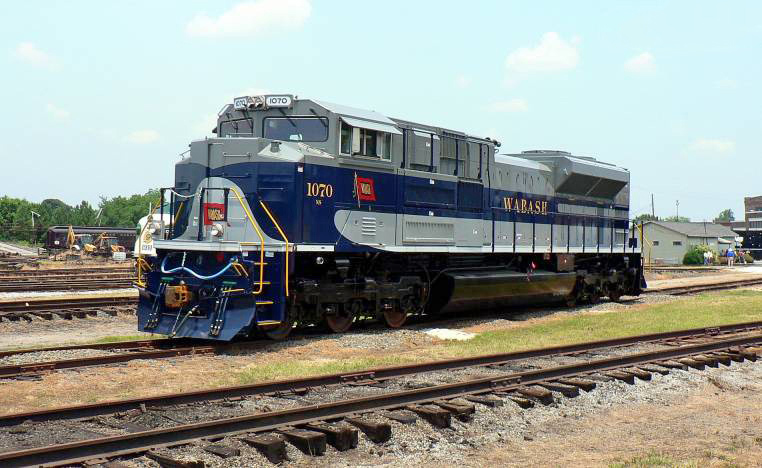 Norfolk Southern's Wabash heritage unit, SD70ACe #1070, at the North Carolina Transportation Museum in Spencer during July, 2012. Dan Robie photo.
Norfolk Southern's Wabash heritage unit, SD70ACe #1070, at the North Carolina Transportation Museum in Spencer during July, 2012. Dan Robie photo.Norfolk & Western Acquisition
The Wabash spent its final decade continuing to provide high quality freight service while angling to cut money-losing passenger trains wherever and whenever possible. As the industry found itself in increasingly uncertain times, particularly in the east, the Wabash suddenly realized its future was in doubt.
The 1950s proved a watershed as railroads struggled to sustain profitability due to increased competition, suffocating government regulation, and an inability to shed unprofitable branches and secondary lines.
Talks of merger sprang up here and there although it was the Pennsylvania and New York Central which made national headlines by announcing just such an intention in 1957. As part of this endeavor the PRR had to relinquish control of its Norfolk & Western interests, then working on a merger with the Nickel Plate Road.
In addition, all parties agreed to have the Wabash included within the N&W-NKP union, made official on December 1, 1960. As part of the deal the Wabash sold its interest in the Ann Arbor and officially joined the Norfolk & Western-Nickel Plate consortium at 12:01 AM on October 16, 1964.
The Wabash was a fascinating railroad with a fascinating culture and even more interesting history. It became widely recognized as a high-speed Midwestern artery with a highly diversified traffic base ranging from auto parts to produce, a trait for which it is remember today.
Public Timetables (August, 1952)
Recent Articles
-
Rio Grande 2-8-2 Locomotives (K-37): Specs, Roster, Photos
Apr 15, 25 12:57 PM
Rio Grande's Class K-37 Mikes were itsdge steamers to enter service in the late 1920s. Today, all but two survive. -
Rio Grande 2-8-2 Locomotives (K-36): Specs, Roster, Photos
Apr 15, 25 11:09 AM
The Rio Grande's K-36 2-8-2s were its last new Mikados purchased for narrow-gauge use. Today, all but one survives. -
Rio Grande 2-8-2 Locomotives (Class K-28): Specs, Roster, Photos
Apr 14, 25 10:24 PM
Rio Grande's Class K-28 Mikados were its newest narrow-gauge steam locomotives since the Mudhens of the early 1900s. Today, three survive.
